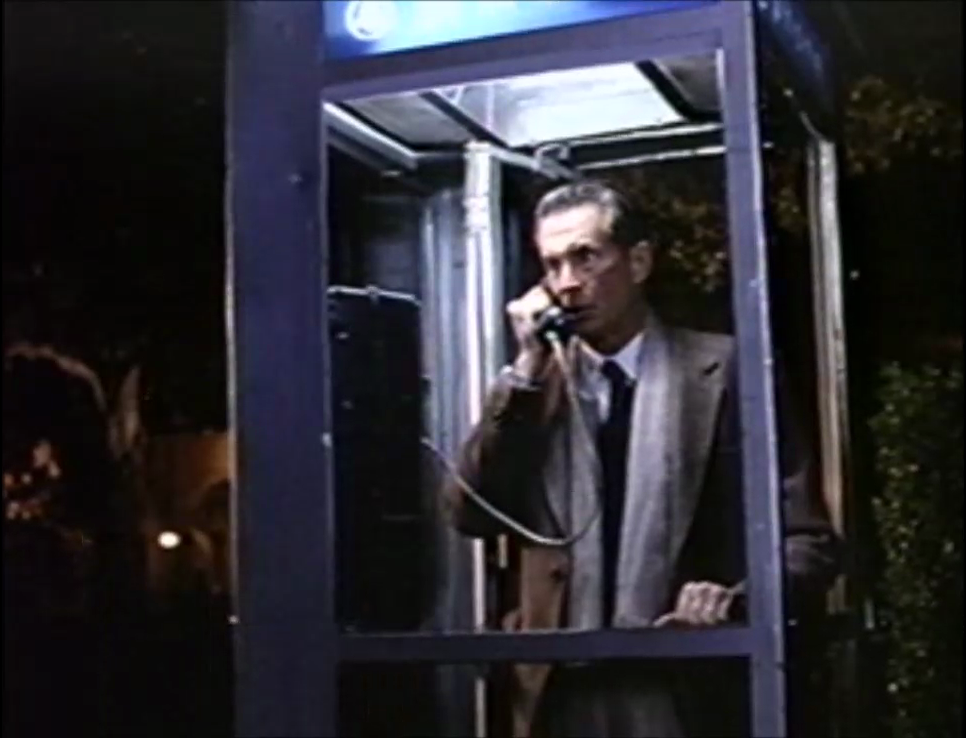
MURDER
YOUR OUTFiT
john cribbs
A version of this article was written and performed for the video variety show Kevin Geeks Out About Tobe Hooper at the Nitehawk Cinema, October 2016. Needless to say, it would not have existed otherwise and I owe many thanks to KGO producer-creator Kevin Maher for inviting me on the panel. Kevin and I were recently joined by fellow Pink Smokers Christopher Funderburg and Marcus Pinn to talk more Tobe with James Hancock on his podcast The Wrong Reel.
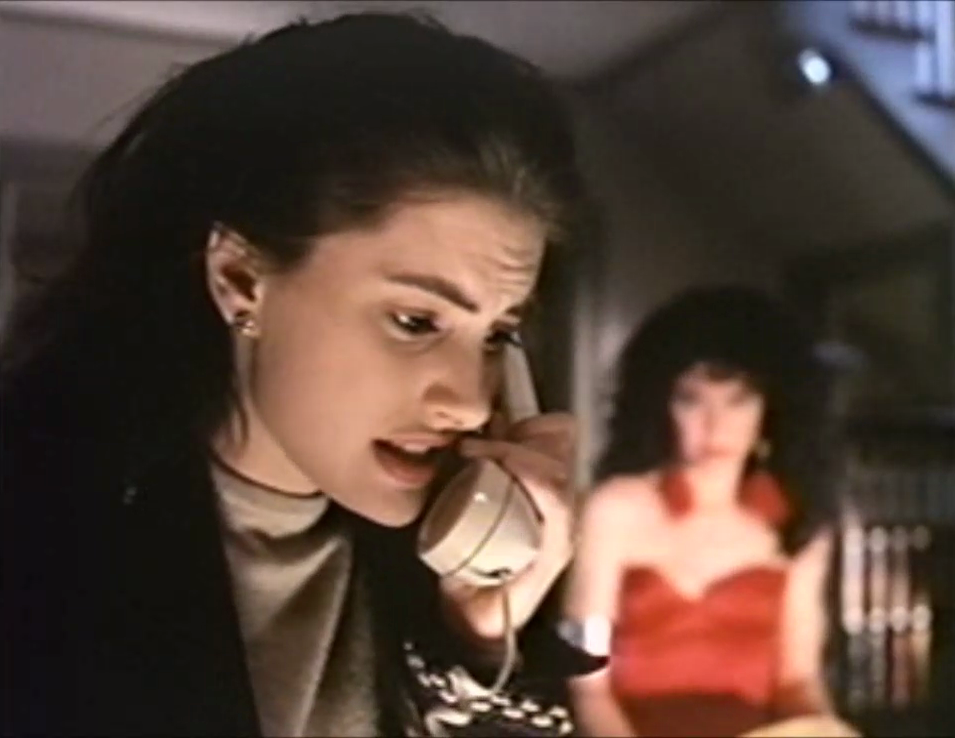
TOBE HOOPER, CLOTHES
& I'M DANGEROUS TONiGHT.
Tobe Hooper is a rebel.
Even in his early filmmaking days, directing commercials and documentaries with MPP/Film House in Austin, he was very much an independent artist going against the grain. They'd send him to shoot an ad for a local bank, and he'd come back with an hour worth of god knows what - hand-held footage of a wasp circling a burning light bulb in slow motion. "Tobe, we just wanted boring shots of people behind desks!" Even when he was working within it, he was always a minority voice against the machine.
As such, Hooper is ardently anti-establishment. This is evident in his career - it's part of the reason he's so often feuded with producers and studios on various projects - as well as his films. In particular, this attitude is strongly reflected by his depictions of clothing... and lack of clothing.
Hooper doesn't trust clothes. They give a false impression of who a person is, projecting a superficial surface over the real thing. Look no further than the scene in The Funhouse with Marco the Magnificent asking for a volunteer from the crowd. He pulls a shy girl in a purple dress up onto the stage and places her inside a standing coffin.
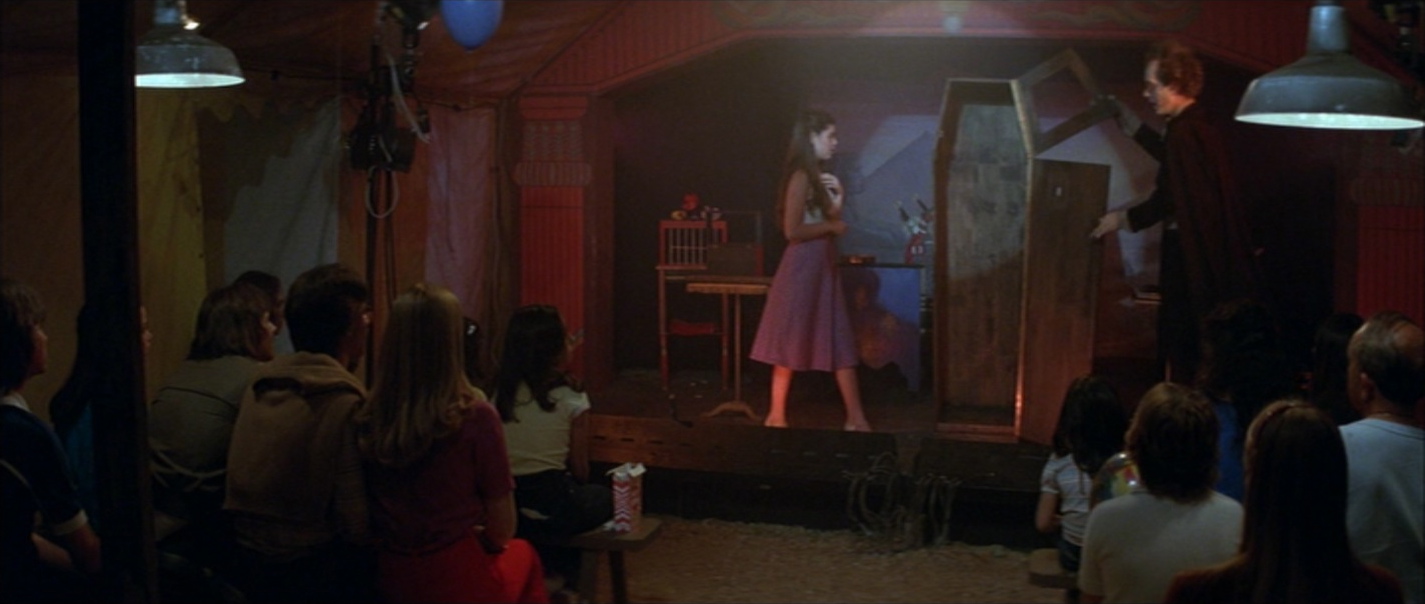
After locking her inside, he proceeds to impale the young woman with a giant stake. Everyone is horrified until Marco opens the lid, revealing that the "victim" is in fact his daughter and assistant (family and famulus). Not only does she exit unharmed, her everyday dress has magically transformed into a revealing stage costume.
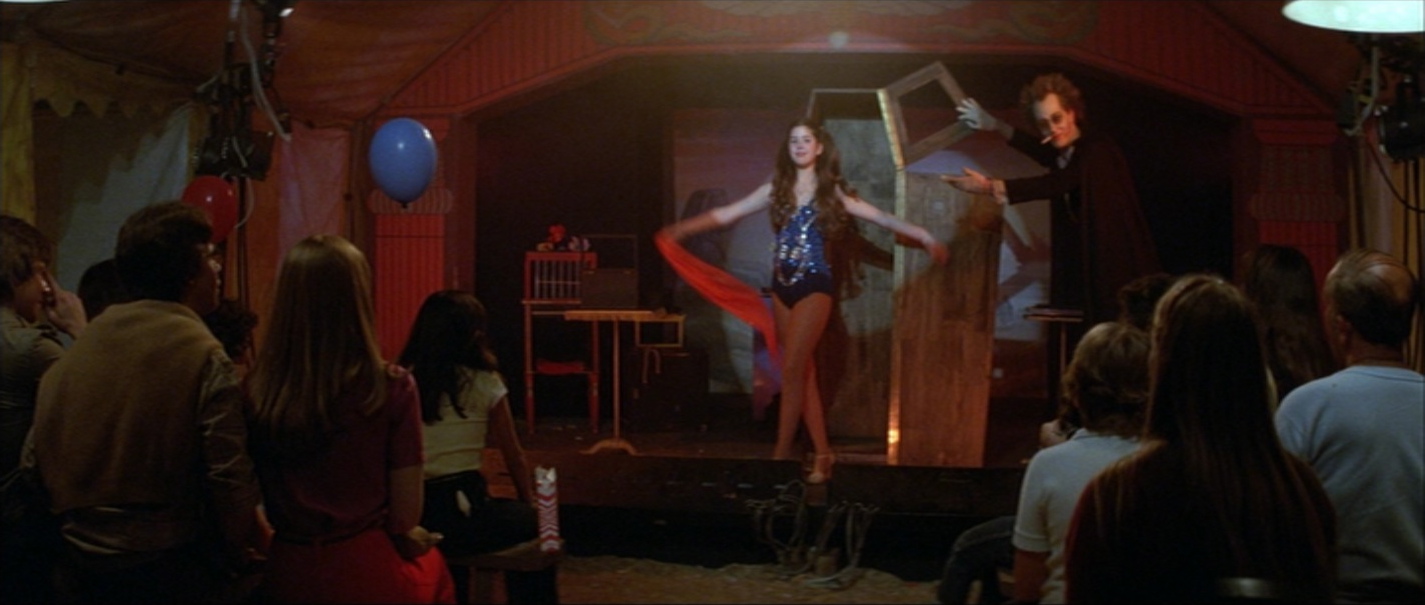
Truth and illusion. The young woman entered as one person and exited as another, wearing notably less clothing.
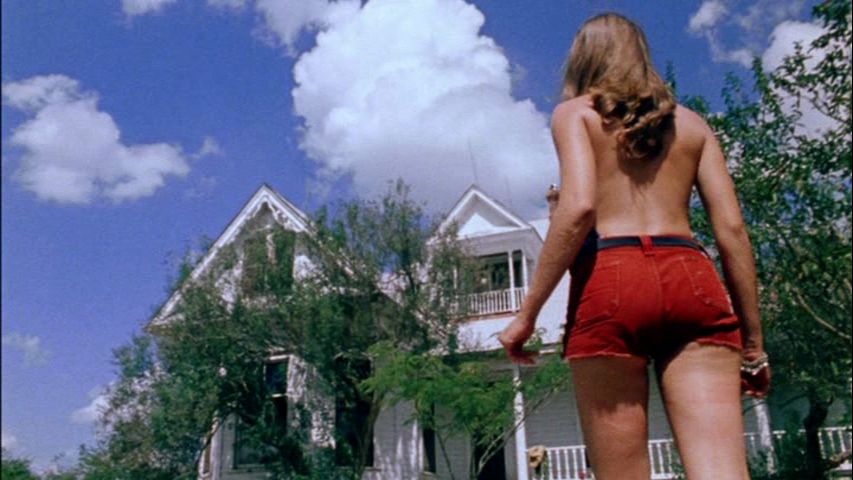
Here is one of the most memorable moments from The Texas Chain Saw Massacre, and one of the most effective tracking shots of all time. It's great for many reasons - the oppressive house dwarfing the individual character and slowly blotting out the blue Texas sky - but one of the most notable aspects is Pam's backless top. We see it throughout the movie, it's a symbol of her free-spirtedness and liberated personality.

"Pam's costume was designed with no back to make her look even more vulnerable."
- Hooper, interview for Interview Magazine.
But once she's in danger, it becomes a symbol of her vulnerability. This is intentional. Hooper is setting up what will become a career-spanning theme: vulnerable characters who feel a false sense of security with what they wear, and what clothes or lack of clothes means for a character coming up against an institution.
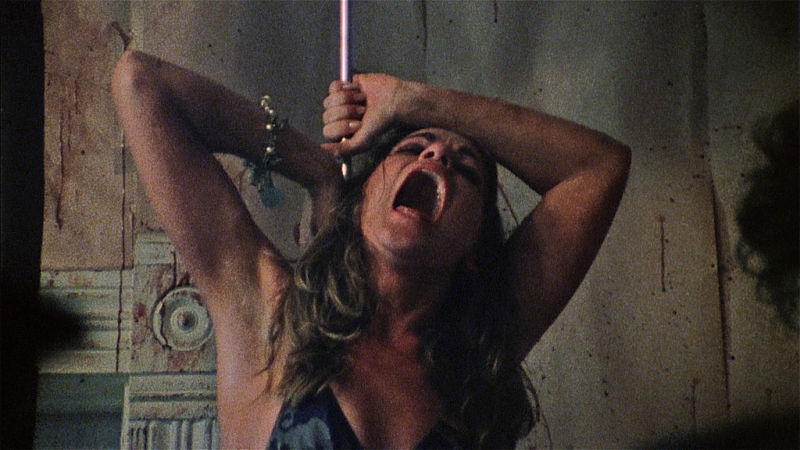
For Pam, it means bad news. What she's wearing makes her a target. She's now literally been put on the meat line. Throughout the finale our final girl, Sally, is chased by a chainsaw-wielding Leatherface and her shirt is ripped until she's also wearing backless clothing. We're subtly reminded of Pam's fate, and want Sally to avoid the same.
Another little subliminal visual to make the audience uneasy: when the gang stops at the Cook's gas station, the rag used by the guy to wash their windshield seems big enough to be a blouse, its previous owner possibly inside the BBQ being offered to the gang?
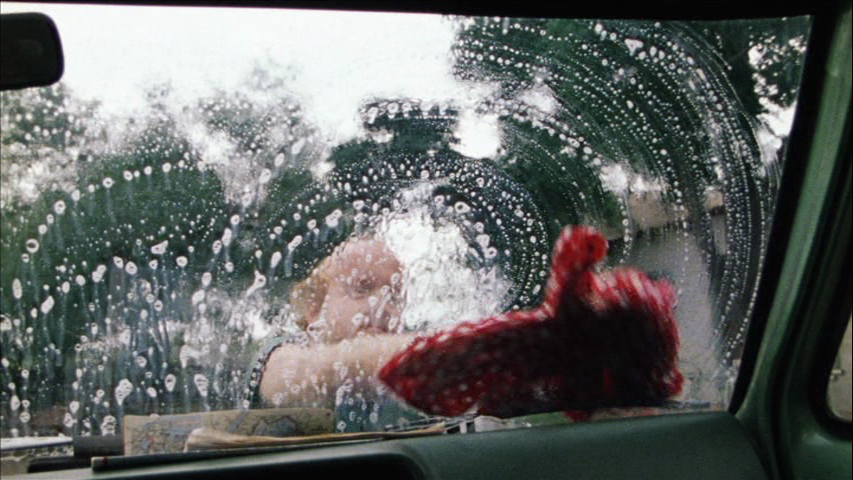
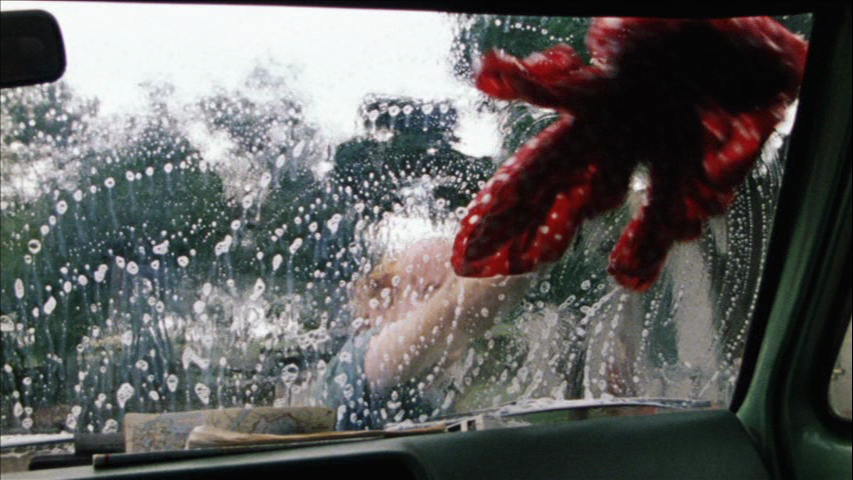
Here are the opening shots of Hooper's next film, Eaten Alive. The first shot is of the moon, which dissolves into a sun.
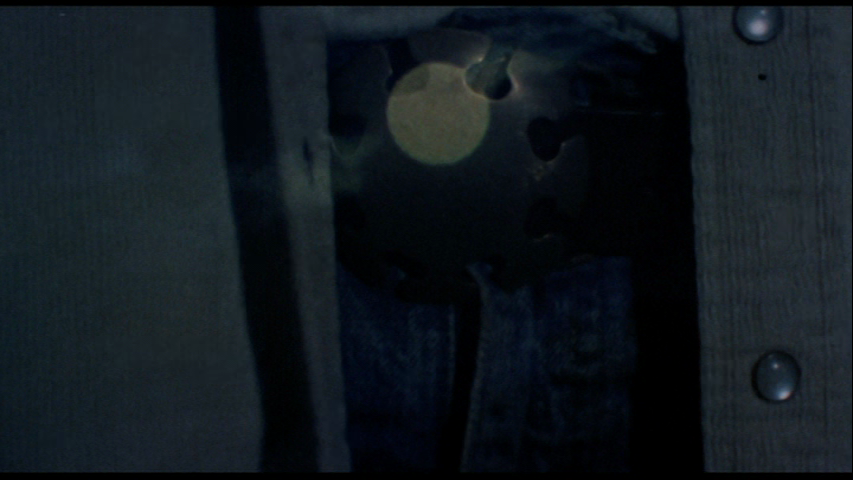
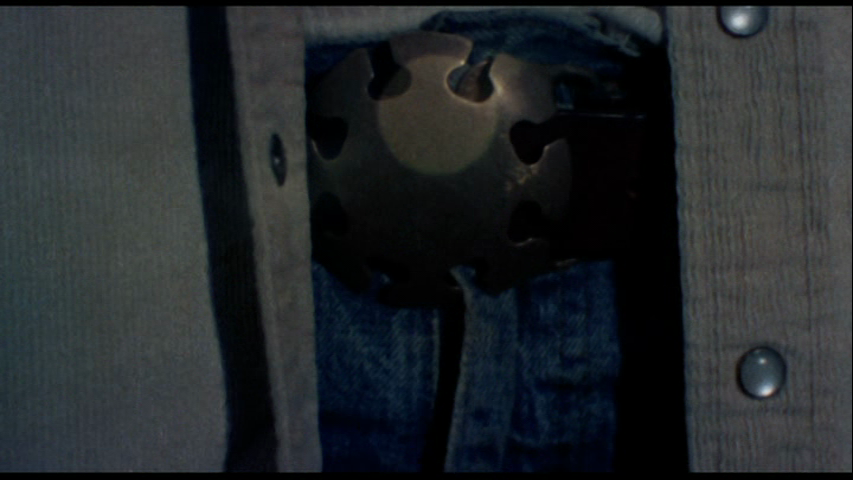
The sun is the buckle on the belt of Buck (yep, Buck's buckle), seen in this extreme close-up as we hear his infamous introduction: "Name's Buck, I'm rarin' to fuck."
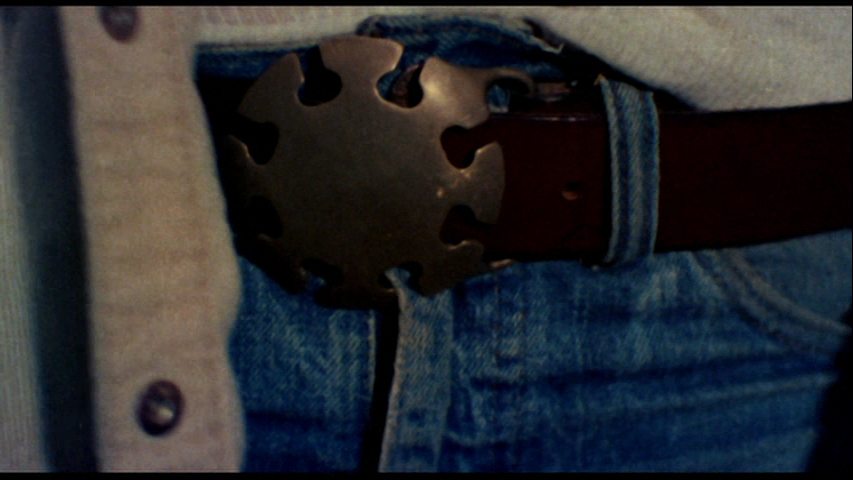
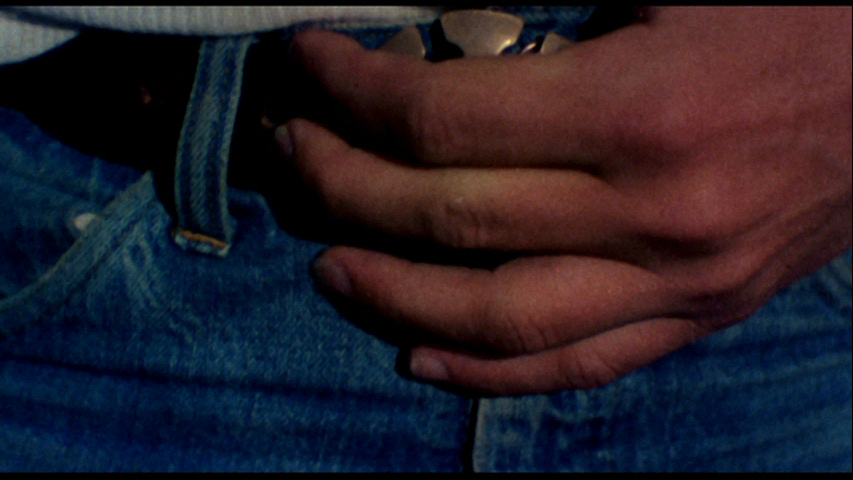
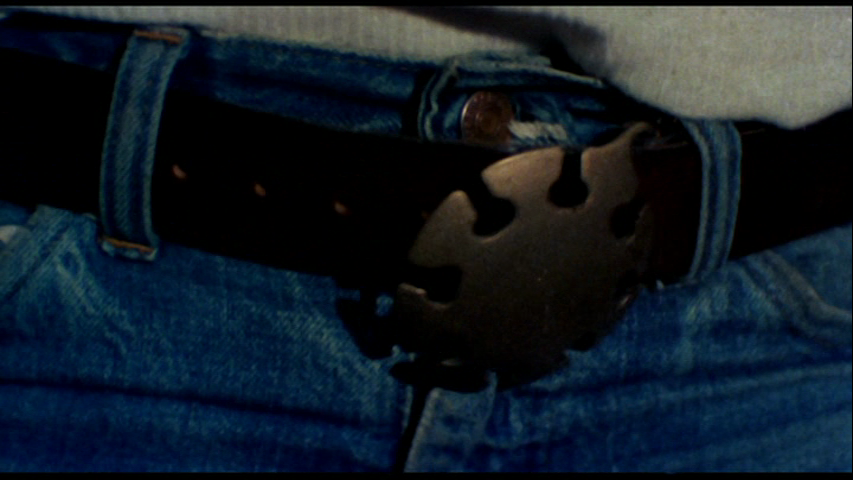
And as the belt comes off, we see this is the point-of-view of Clara, who obviously feels threatened by Buck's clothes being removed.
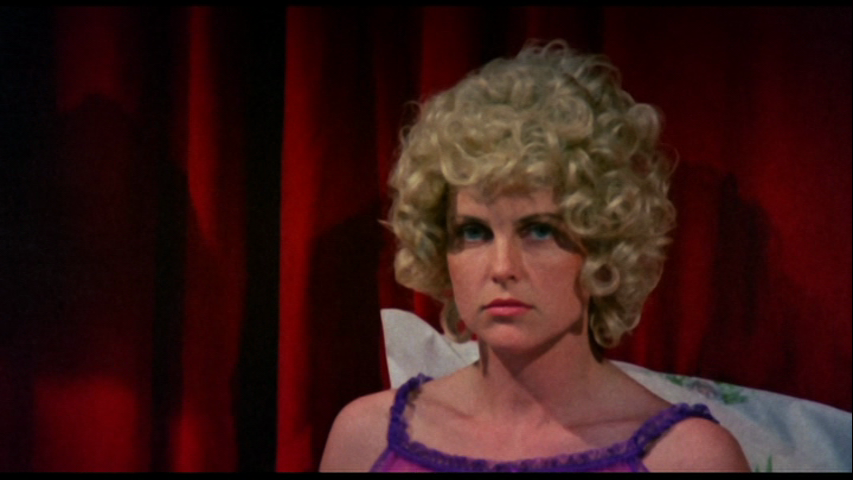
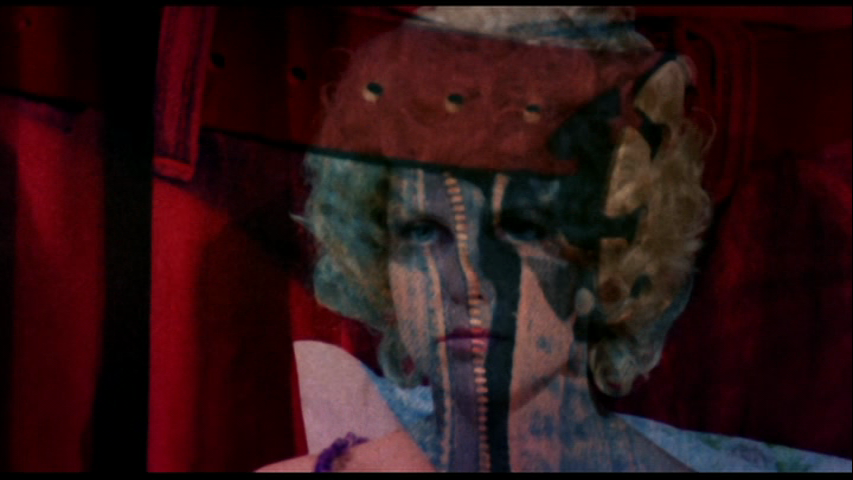
Further dissolves make it look like her face is being ripped open as the zipper comes down. Then we see what she's wearing: a see-through negligee. Like Pam, she's clothed but her flesh is exposed and the threat is more directly sexual.
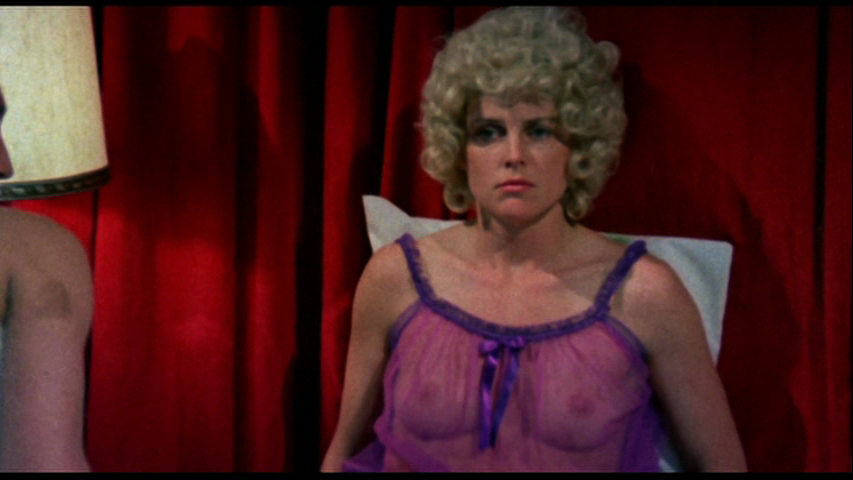
Poor Clara.
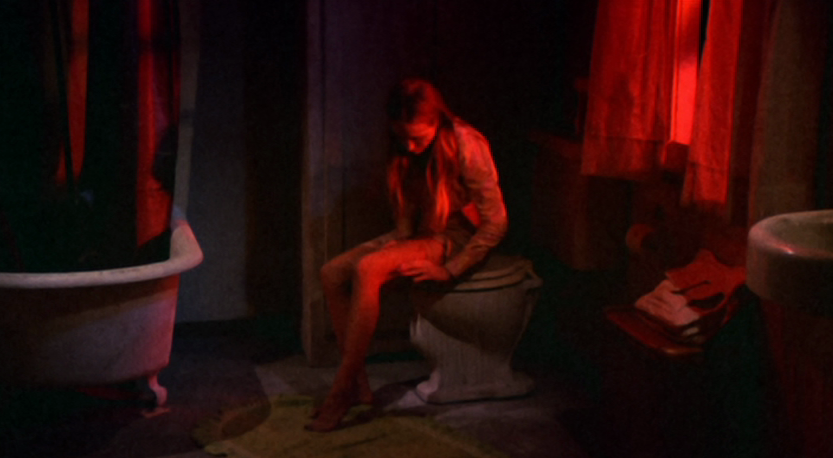
In a scene from later in the same movie, another character, Faye, is going to take a shower. Faye's had a bad day. Her dog's been eaten by a giant crocodile, her daughter is in a near-catatonic state, her husband is freaking out and barking at her, and you see can by the way she disrobes so slowly, shedding so many heavy layers of clothes, that it's a very purposely un-erotic scene of a woman stuck in a dingy hell-ish motel who just needs to wash off this horrible experience and is finding this simple task impossible.*
It's a thoughtful reflection on how women are shot in horror films, especially since the film appropriates the Psycho scenario of the hotel owner attacking his tenant in the bathroom, but we're specifically denied the shower scene. (The scene is filmed from a single camera set-up, a notable contrast to Psycho's famous multi-shot shower murder.) Moreso, Faye's methodical shedding of her clothes is guarded, like she's worried that losing them will make her more vulnerable.
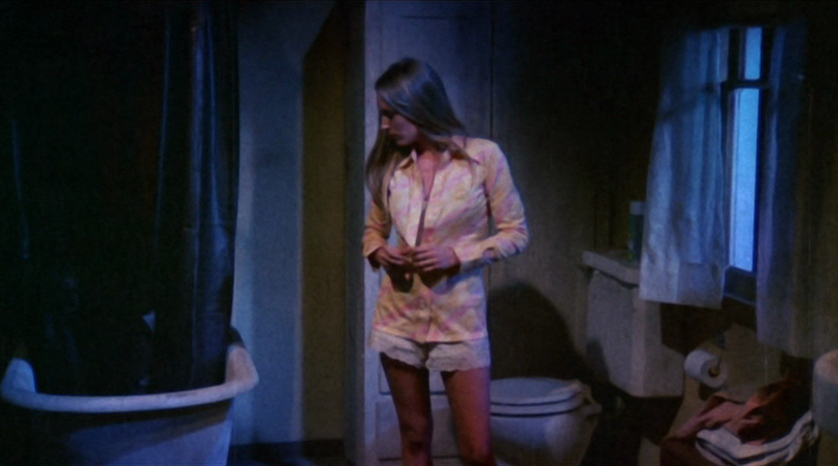
I love this scene, but I have to admit: it wasn't directed by Tobe Hooper. Marilyn Burns (who plays Sally in Texas Chain Saw and Faye in Eaten Alive) revealed that the scene was shot after Hooper left the production following numerous dust-ups with the head office:
"The producers added a little scene - they were dying for me to take my clothes off - so I gave them the longest bathroom scene ever without letting anyone see anything! They all sat up waiting for my nude shot, and I ended up taking off so many clothes - I still had a chemise, bra, panties and little shorts on! And it still took twenty minutes to get everything I was taking off." - The Texas Chain Saw Massacre Companion, Stefan Jaworzyn.
So Hooper wasn't actually involved in the direction of this scene, but its inclusion with the Burns anecdote in mind makes it seem symbolic of Hooper refusing to give in to the Man after his artistic vision was impeded, as he was constantly forced to do in his career. In standing up to the sleazy non-artists in charge, Marilyn Burns incidentally taps into the plight of the individual that reflects Hooper's attitude through his characters: Leatherface tried to disrobe her and failed, these producers sure as shit weren't going to be successful!
Of course, in Hooper's recurring bouts the studio bosses would always have their way in the end: just like Faye, who finds that being fully clothed does not mean the boogeyman isn't barging into the bathroom to get her.
Conversely, The Funhouse opens with main character Amy being attacked while she's naked and vulnerable in the shower, a Psycho parody/homage. But it turns out to be a hoax: the "killer" is her little brother, the knife is rubber, Amy was never in any real danger, even completely exposed with no protective covering.
She's in very real danger in the climax of the movie, when she's fully clothed. And, like Pam and Sally, her blouse is torn during the struggle, temporarily exposing her back. This just happens to be a result of her top getting caught in the cogs of the large gears that run The Funhouse, the insidious foundation that has claimed the lives of all her friends.
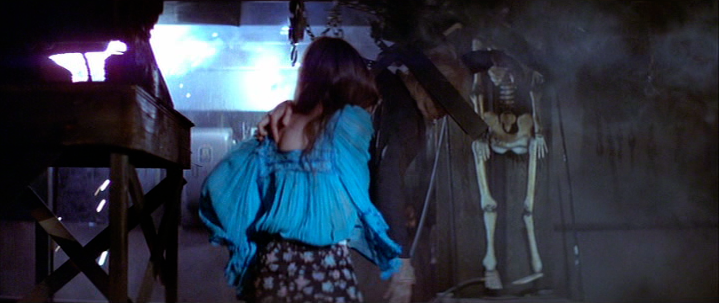
When Hooper moved from Funhouse into the mainstream with Poltergeist, he had his female lead take comfort in clothes. Like Faye in Eaten Alive, Diane Freeling's going through some serious trauma with a kidnapped daughter and a house that's actively trying to kill her and her family. In the middle of the film, she feels Carol Anne run "through her" from the Other Side and exalts that she can "smell" her absent daughter all over her, specifically on her scarf, which she holds up for husband Steve to confirm olfactorily.
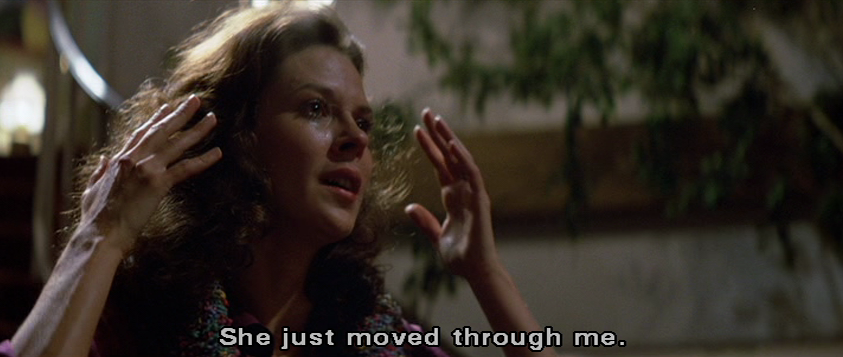
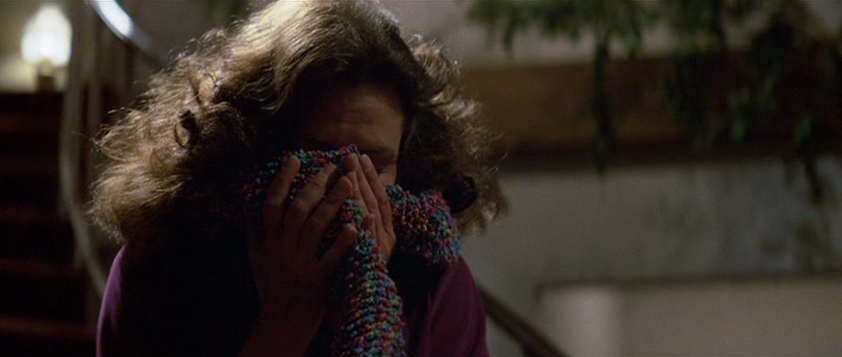
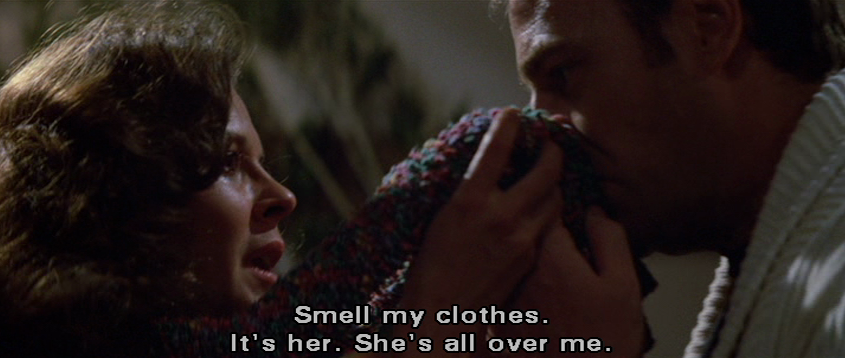
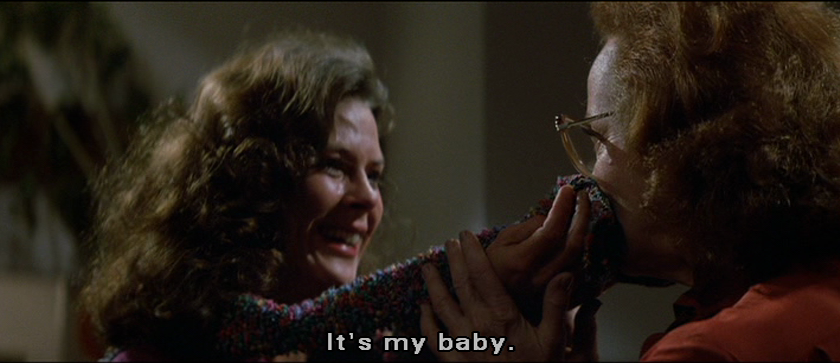
Clothes become a way for Diane to translate the ethereal experience into something tangible, making this the film's most religious moment. The scarf grounds her to reality, giving her hope that she and her family will pull out of this supernatural ordeal intact. Similarly, Hooper's most recent film Djinn finds Salama, another mother who left her faith behind after moving to America, wrapping herself in a hijab and praying intently on her knees when a demonic force invades her apartment. Using a piece of meaningful clothing - a piece of fabric tied to the spiritual but belonging to the very real world - as protection keeps her safe, but only temporarily.
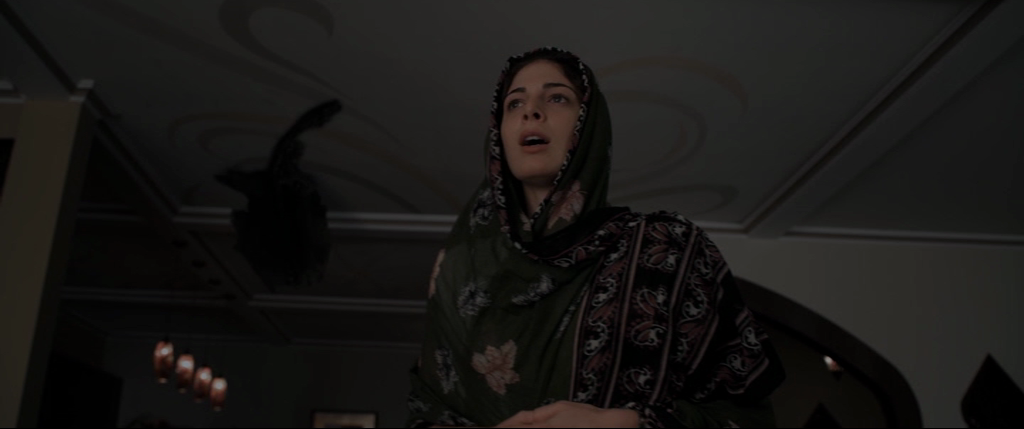
Diane's own lapsing back to religious beliefs, stimulated by her moment of rapture with the scarf and encouraged by Dr. Lesh, comes crashing down later in the film when she tries to call out to Carol Anne again outside the door to the kid's bedroom, the "heart" of the house. She's clutching a pile of laundry against her chest, almost as one would a rosary, hoping to recreate that earthly bond between them. It doesn't work this time, and Diane is devastated to tears.**
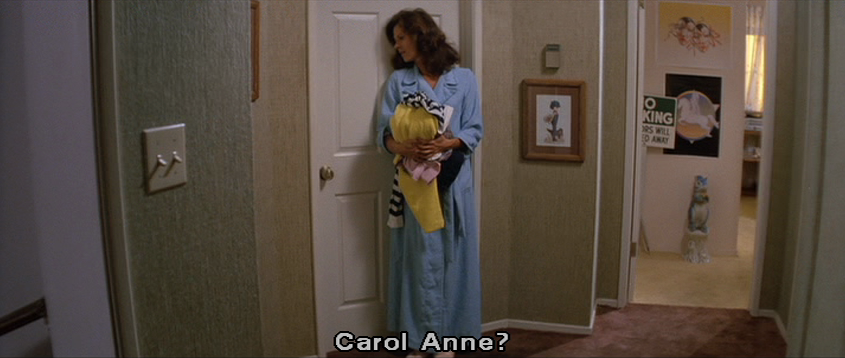
Given the invasive and displacing nature of her haunting, it makes sense that Diane would seek to ground the situation and do whatever she can to return a sense of familiarity to her own home. After Tangina has declared the house "clean", Diane immediately reverts to a feeling of comfort, strutting around in a t-shirt with no pants on.*** The Poltergeist's attack on her, apart from queasily resembling a sexual assault, becomes a direct violation of her personal security. Like Pam in Texas Chain Saw and Clara in Eaten Alive, she's attacked while she's not wearing much. Genie in Night Terrors also finds herself the victim of a group of men when she boldly walks the marketplace of Alexandria, revealing plenty of skin as an expression of her confidence and personal freedom. (One of her would-be assailants, left only with a jacket he's managed to grab off her, gives it a big whiff just like Diane with the scarf: even deplorable characters find artificial satisfaction in the smell of clothes.)

Doing laundry is how Nell Barrows customizes herself to new surroundings after moving into her new apartment at the uninviting labyrinth of Lusman Arms in Toolbox Murders. Feeling confident after navigating her way to the laundry room through the twisting bowels of the building, she becomes visibly more at ease going through the familiar process of operating the washing machine while chatting up new neighbor "Chas" Rooker, who's taking a pair of boots out of the dryer. The routine at least temporarily staves off the heebie jeebies provoked by the menacing building and its imposing inhabitants.
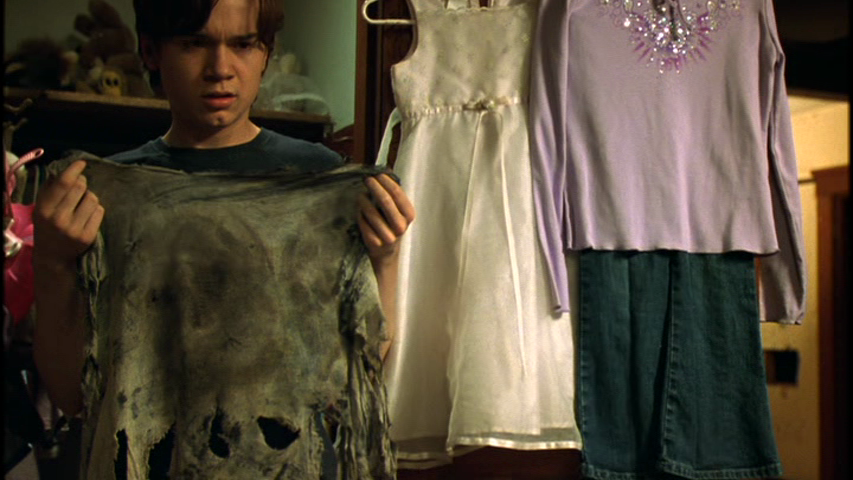
In Mortuary, the intimacy and security associated with laundry is soiled when the Doyle family discover the grimy burial shroud of undead Bobby Fowler among young Jamie's clean clothes in her closet. This sets up the infection that threatens to corrupt the entire family via a sentient black fungus which first manifests as mold on the walls of the Mortuaryand eventually takes over the bodies of those close to the Doyles, a corruption from which Jonathan is forced to protect his younger sister.
Another child character is threatened by the otherworldly in Hooper's remake of Invaders from Mars. Clothes play a significant part in both the film and its novelization. Author Ray Garton even opens the book with clothes:
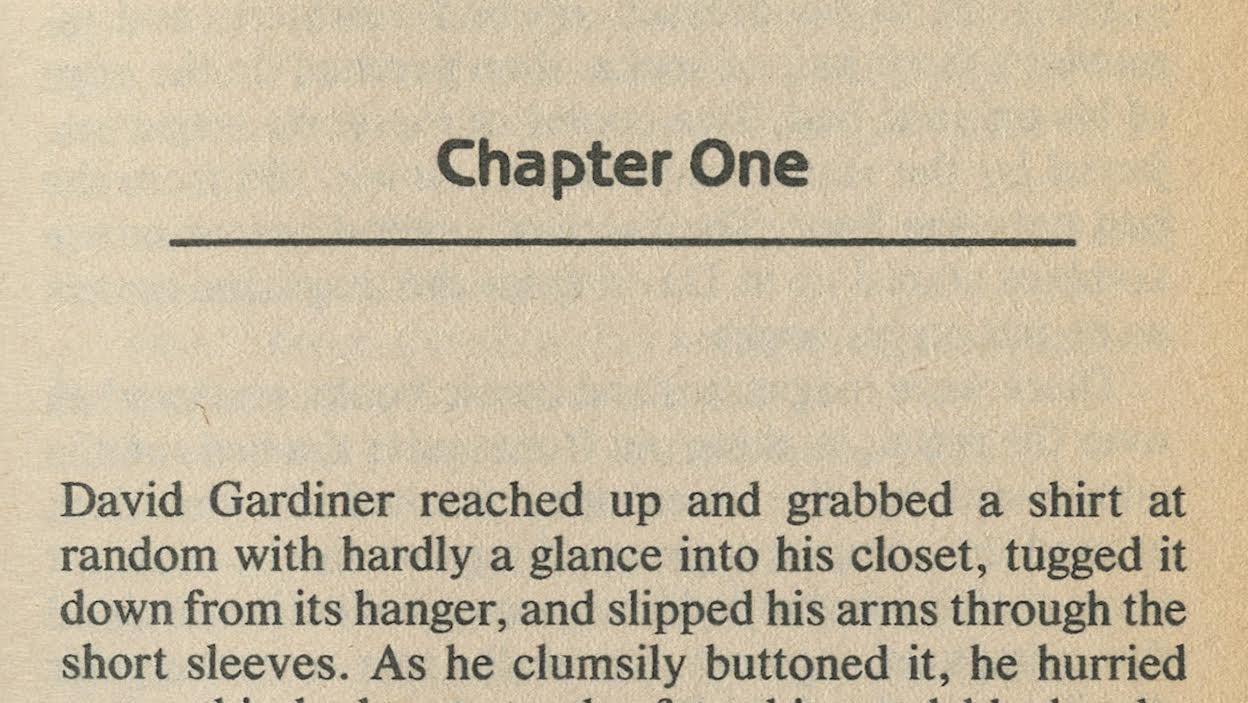
This isn't how the movie opens, but clothes play two important roles in defeating the body-snatching Martians:
1) David Gardiner is made hip to his father's non-humanness because he's walking around with only one slipper and hasn't noticed. Aliens in the film have no use for or familiarity with clothes.
2) The rare coin that ends up saving the day is placed in the pocket of David's Junior Letterman jacket early in the movie; he specifically goes to retrieve the jacket from his school locker in a moment that seems almost superfluous until we realize that it's literally going to be the thing that foils the alien plot. David's reliance on his jacket, the fact that he feels he needs it when going into battle with the evil forces that are slowly corrupting his world, ends up saving it.
On the other hand, it's all an illusion! The epilogue reveals the entire film's been a dream, and that David's beneficial perception of clothes to recognize possessed humans and ultimately defeat them - the security he feels by pulling a shirt out of the closet and slipping his arms into the sleeves - has been a fallacy of his own mind.
Still, up to that moment Hooper does suggest that common clothes can defeat aliens. But even that's pretty useless when the aliens...
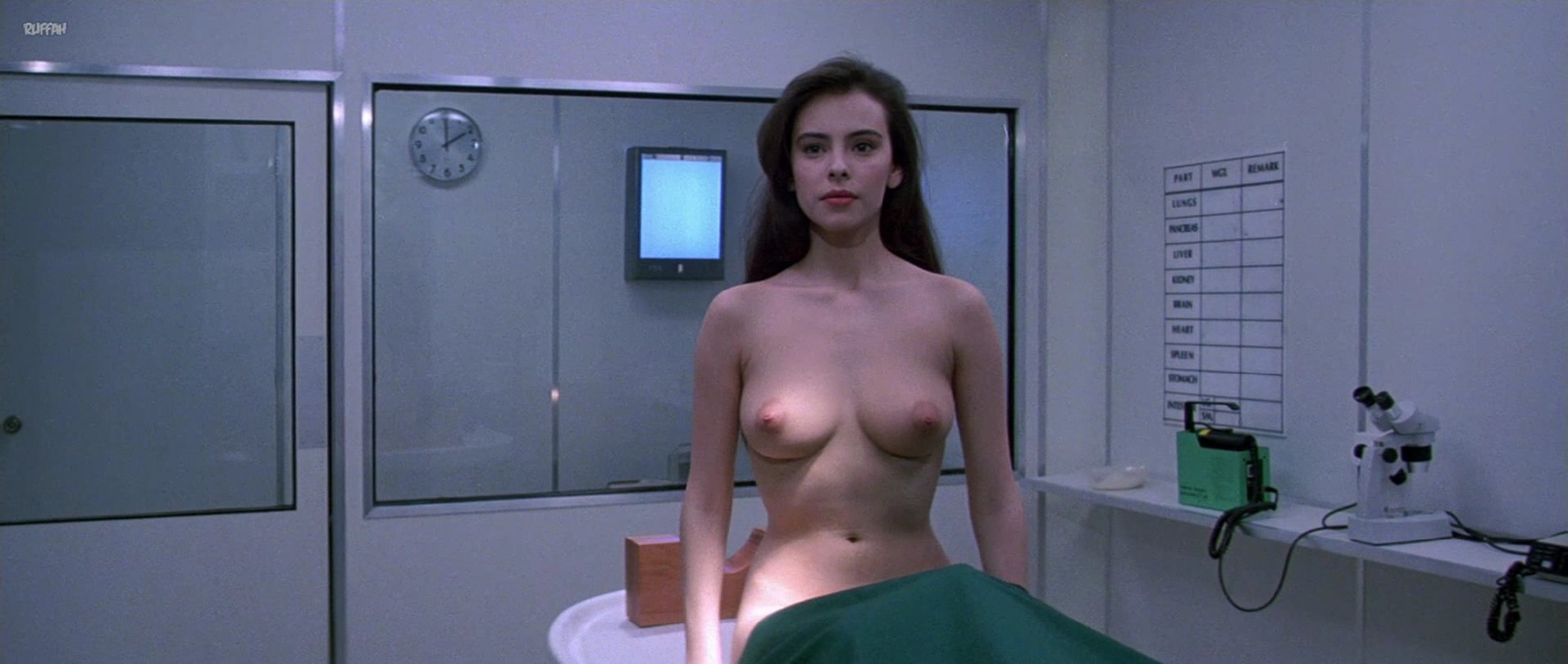
...have no use for clothes.
Lifeforce was Hooper's film directly following Poltergeist, and is as subversive a major Hollywood movie as Poltergeist was a surefire crowd-pleaser. Because of that, all veneer of clothes as "comfort" is jettisoned and instead we have a female character who confidentally uses her lack of clothes to overwhelm and subdue the all-male supporting cast.
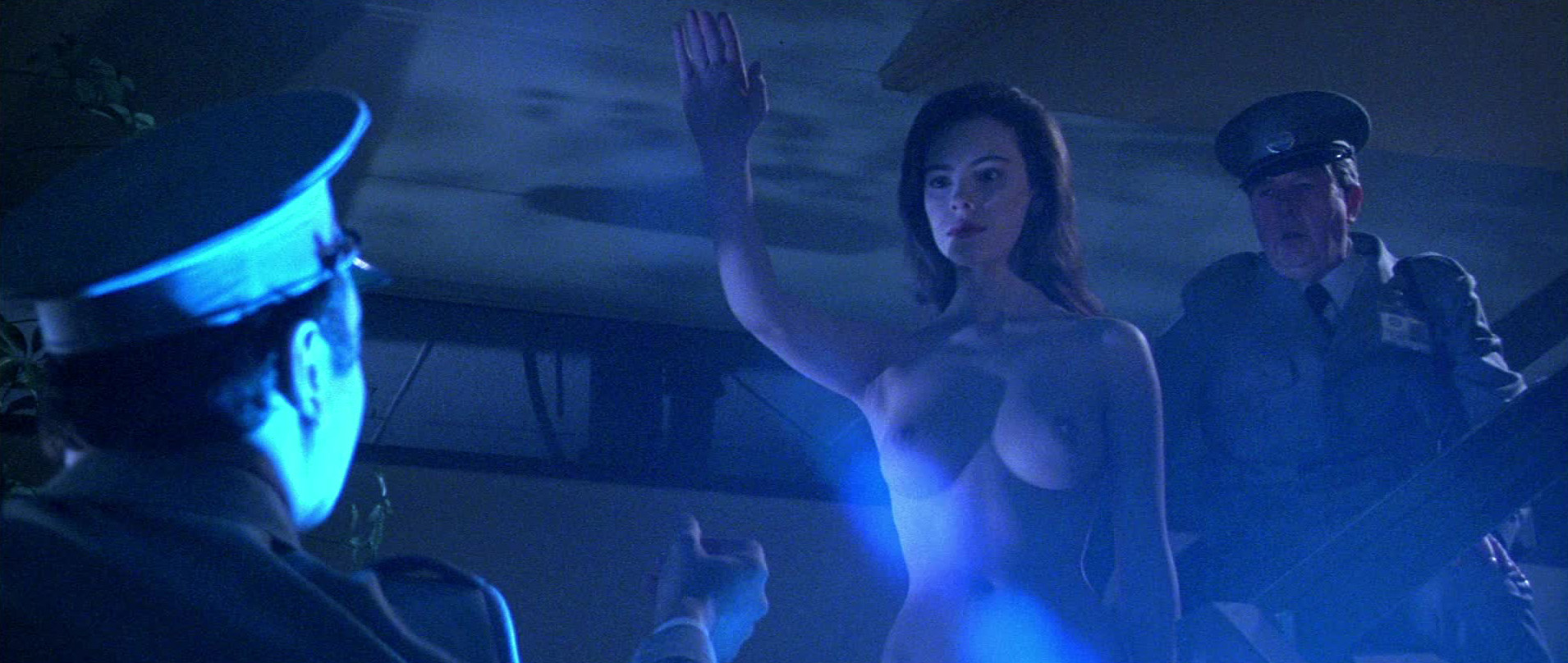
"I wanted her to have a kind of replicant feeling, you know like in Blade Runner, but I think she was better than the replicants. And none of them went down to their natural costumes. After 117 shooting days, the lack of costume was her costume." - Tobe Hooper, Shock Till You Drop interview.
Security guards at the Space Research Centre have been informed that the Space Girl is dangerous, but approach her apprehension mockingly when she reveals herself wearing only a smile. Their uniforms clearly bolster their authority and position - of course, most of the male figures in the film are dressed very "officially" in suits and uniforms - and cause them to underrate the seemingly harmless lifeform in the shape of a naked woman. She's the paragon of Milton: "In naked beauty more adorn'd."
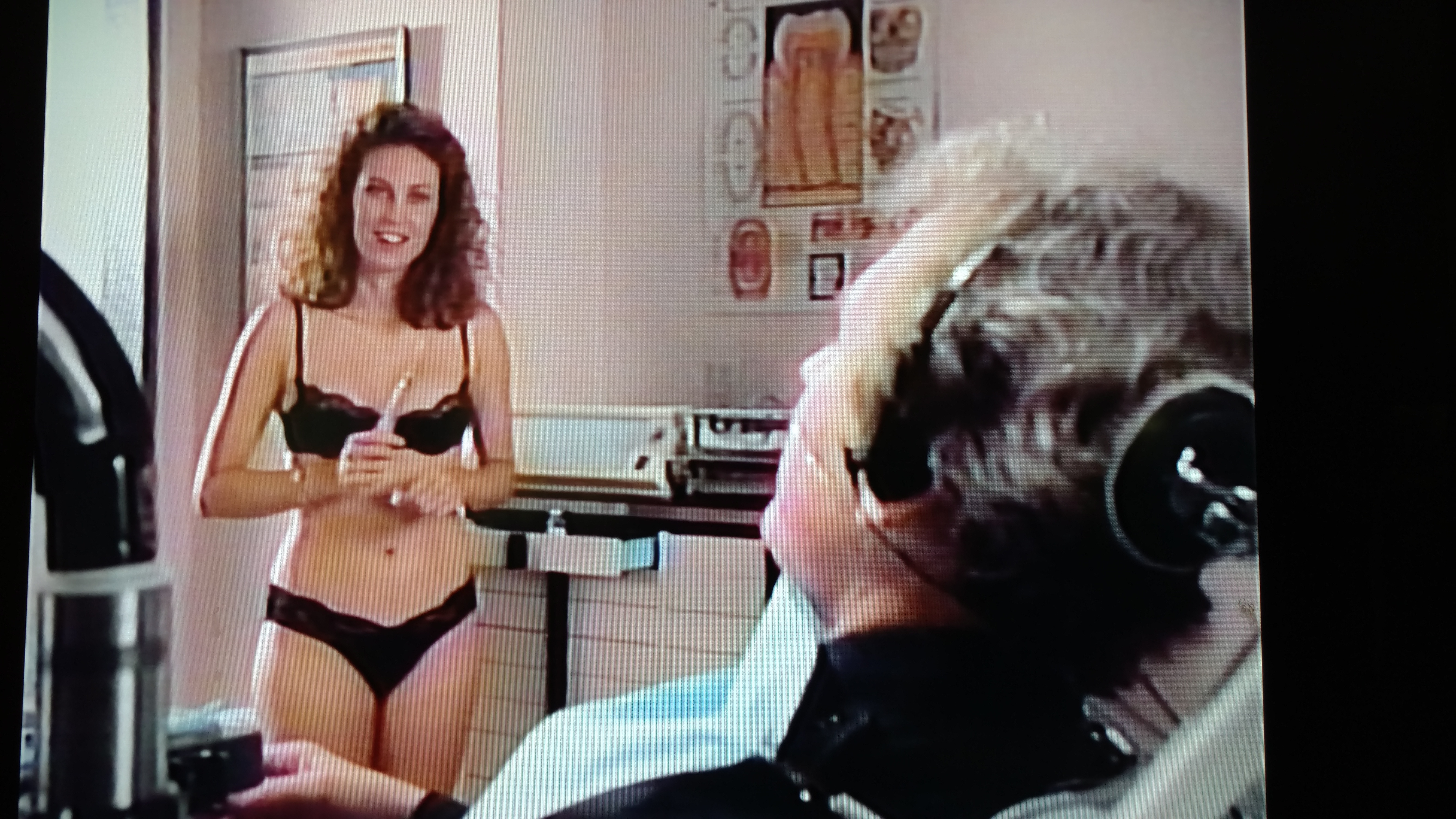
Similarly, the only "nightmare death" scene from "No More Mr. Nice Guy," the pilot episode of Freddy's Nightmares directed by Hooper, involves Lt. Timothy Blocker grinning stupidly at the sight of a female dental assistant in her underwear. ("You know this gas lets me see through your clothes!") Having that "advantage" over her puts him at ease; he doesn't realize that it's Freddy in disguise until it's too late and meets the same fate as Lifeforce's gawking security guards.
After Space Girl escapes the facility, the male scientists and military types are even more threatened after finding a disrobed victim and realizing: "Now she has clothes!" What they don't understand is that she's been wearing "clothes" the entire time. She's really a giant hairy space bat - her various human forms are ostensibly outfits. In fact it's her lack of dependence on clothes that makes her Hooper's most successful monster, on the brink of bringing all of London to chaos and ruin, its population a horde of energy-sucking zombies, until the end of the film, when Hooper sets her up in St. Paul's Cathedral wearing a silk white dress.
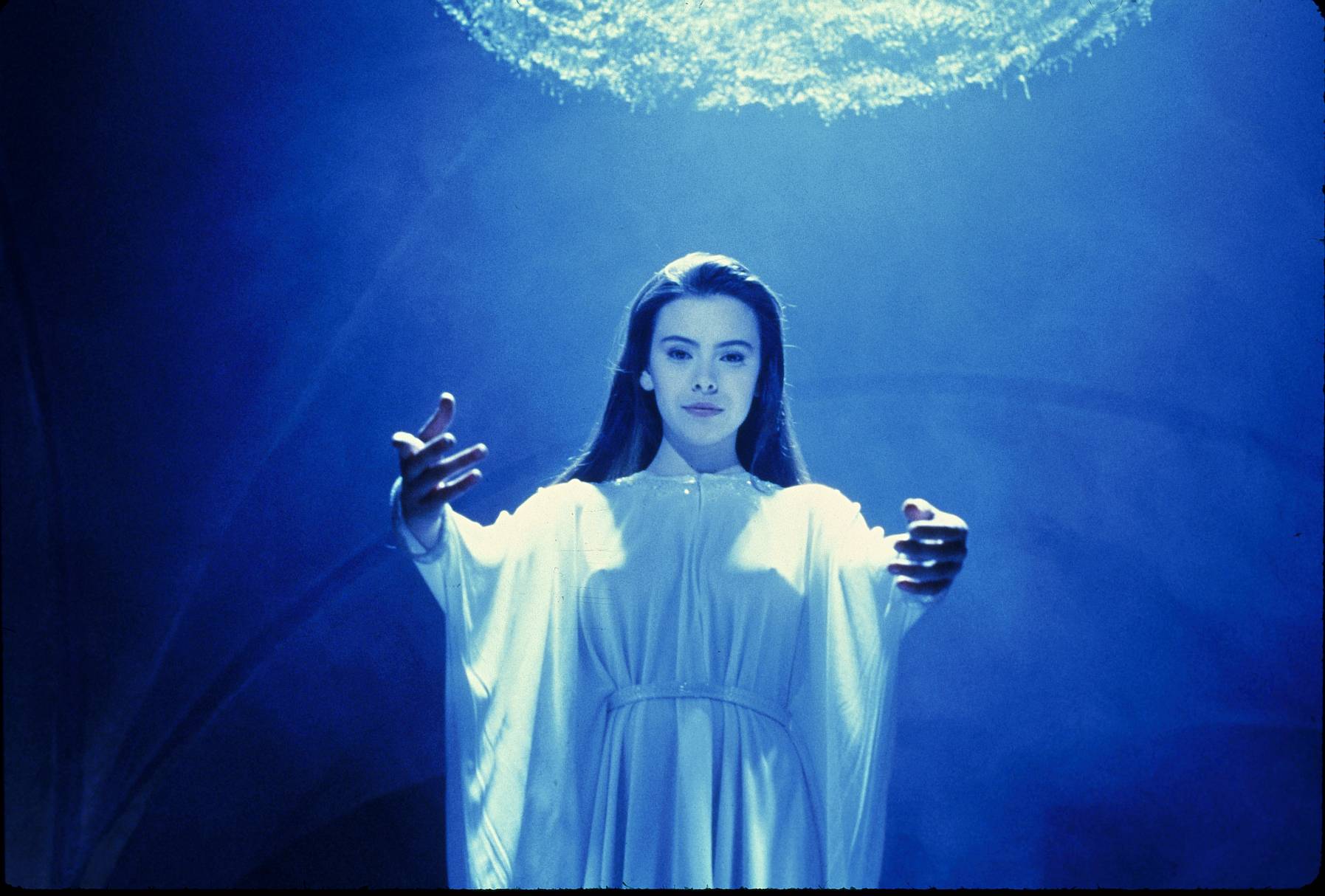
This white dress is a recurring costume in Hooper's films, especially once a female character has turned into a monster.
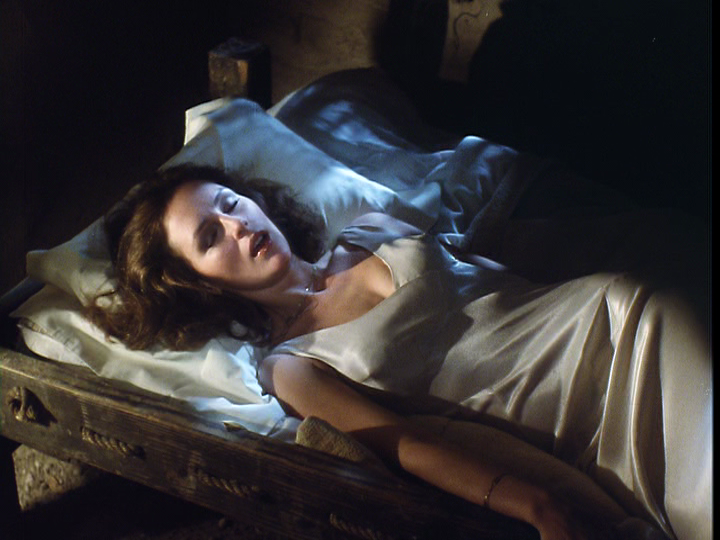
It's worn by Susan Norton in Salem's Lot**** once she's revealed as a vampire...
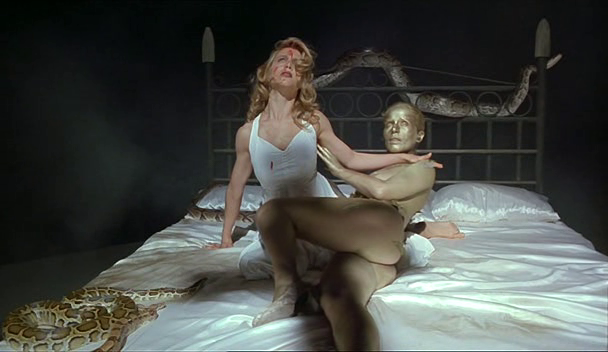
...Genie in Night Terrors as she is gradually corrupted by Paul Chevalier and Sabina...
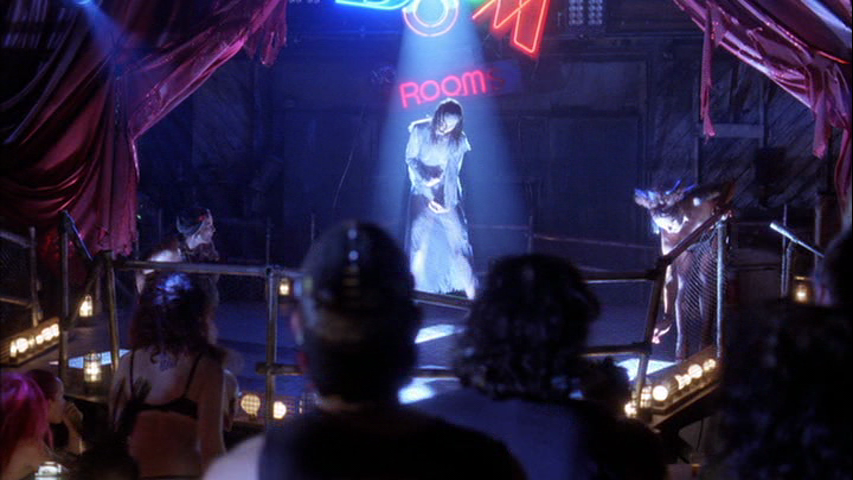
...Anna and Kate in the Doom Room after they're turned into slave-zombies forced to dance the "Dance of the Dead" in Hooper's first Masters of Horror entry.
Hooper subverts the kind of holy, virginal implications of a white dress by having it stand for corruption: being forced into the collective rather than living as a recognizable, individual human being. Essentially, if you're caught wearing a white dress in a Tobe Hooper movie it means you sold out to the powers of evil. You blew it.
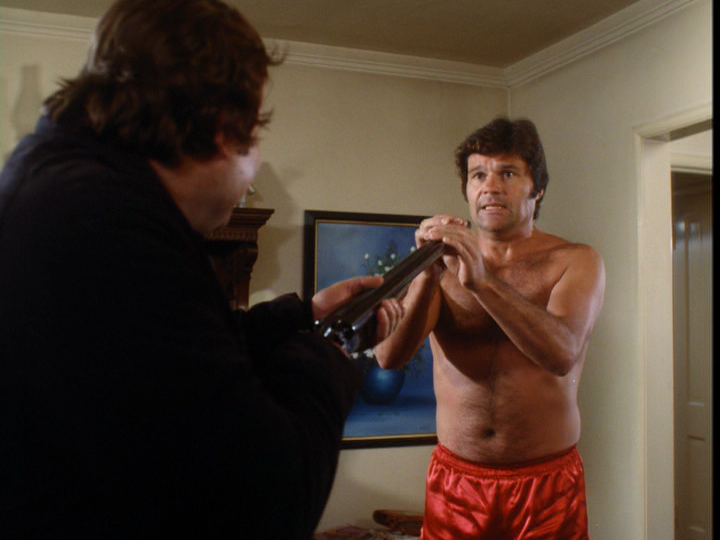
Not sure how Fred Willard's fancy red silk boxer shorts fit into this argument, but he is wearing them when he's turned into a vampire. And it's interesting for all the endless arguing over whose was the true creative voice behind Poltergeist that both Spielberg and Hooper later used a girl in a prominent red outfit to symbolize innocence in a time of genocide, in "Dance of the Dead" and Schindler's List, respectively.

In Dance of the Dead, a horrible cataclysm has occured and the ones who survive remain traumatized by the day so many people were killed. Hooper's decision to focus on a peripheral girl in a red dress as the one who haunts the memories of the survivors of this travesty feels like a possible little rib to old buddy Spielberg.
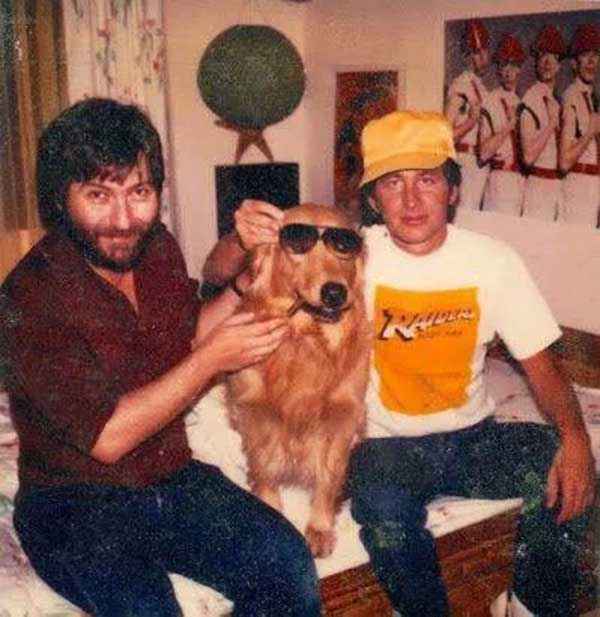
Here's a question: What's something you never see Tobe Hooper wearing? (Other than a t-shirt for his own goddamn movie?)
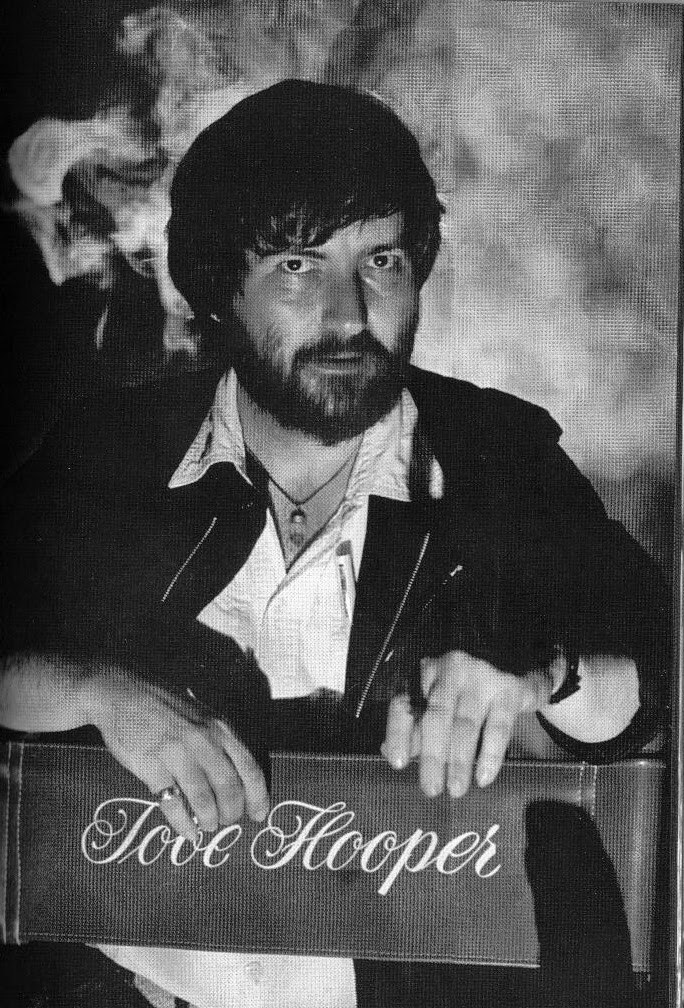
TIES.
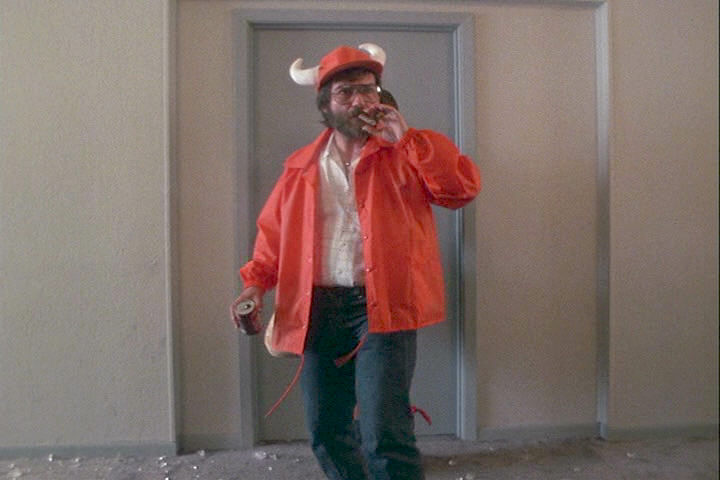
Ties mean working within the system. Ties are the establishment. Tobe Hooper is anti-establishment and therefore stauchly anti-tie.

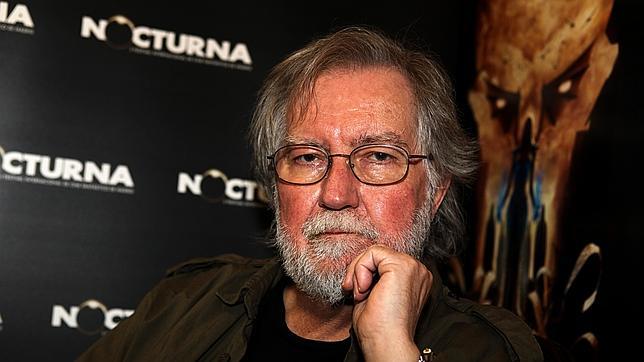
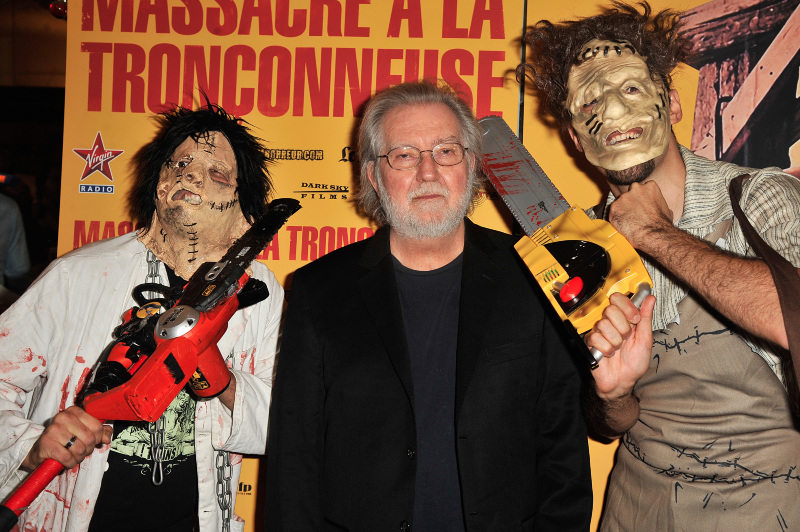
For him, ties represent:
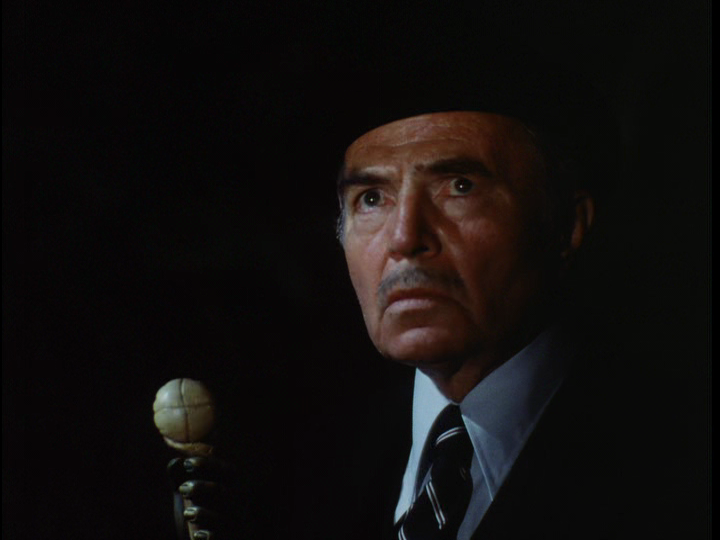
Richard Straker in Salem's Lot.
- Corruption
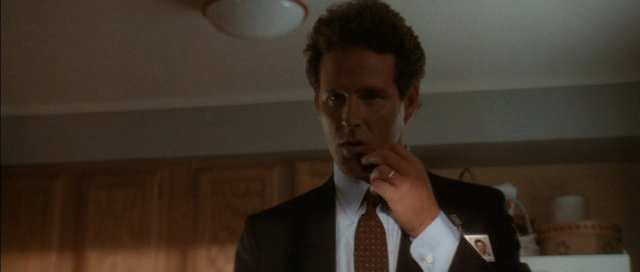
The alien-controlled George Gardner and his alien-controlled associate in Invaders from Mars.
- Conspiracy
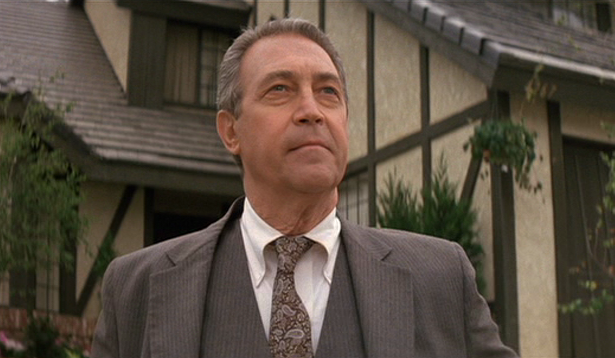
Mr. Teague in Poltergeist.
- Corporate greed
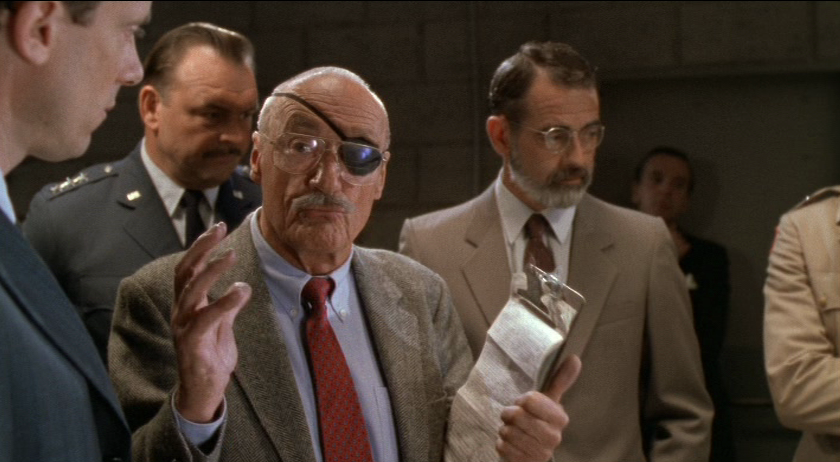
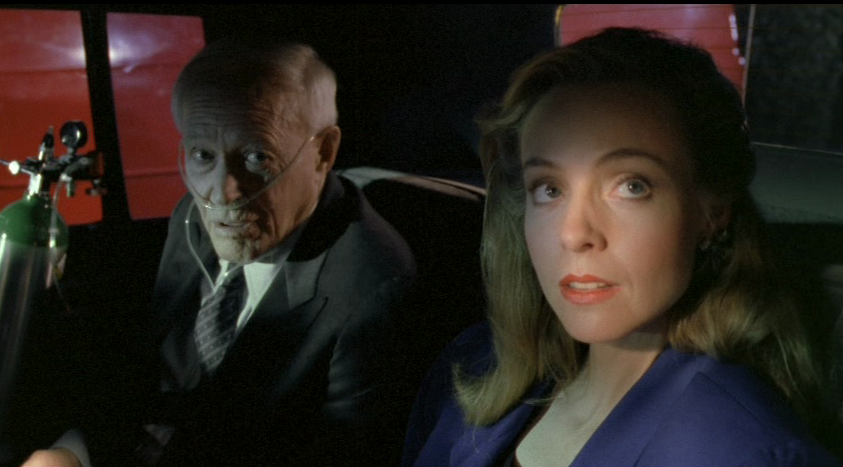
Lew Orlander and friends in Spontaneous Combustion.
- Treachery
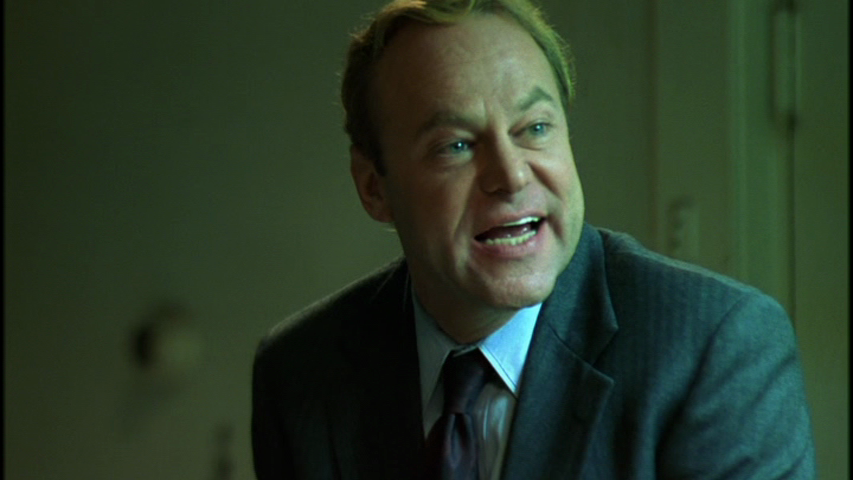
Eliot Cook in Mortuary.
- Hypocrisy
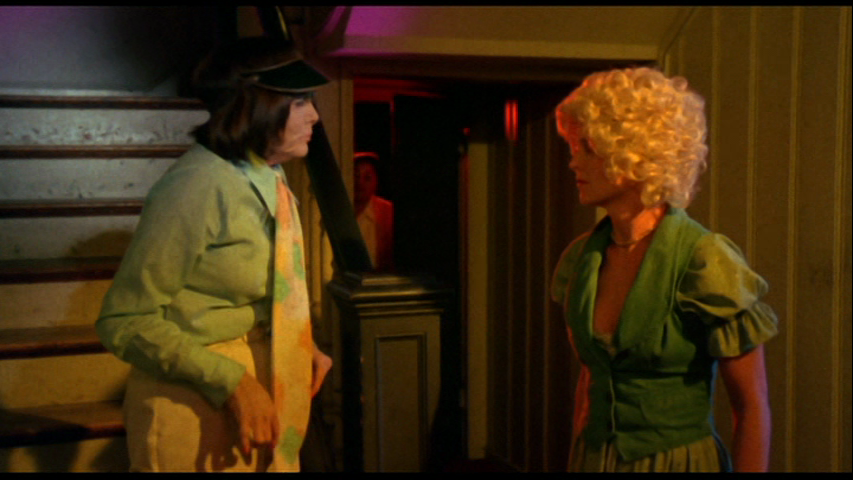
Hattie in Eaten Alive, who - yes - also wears a hat.
- Exploitation
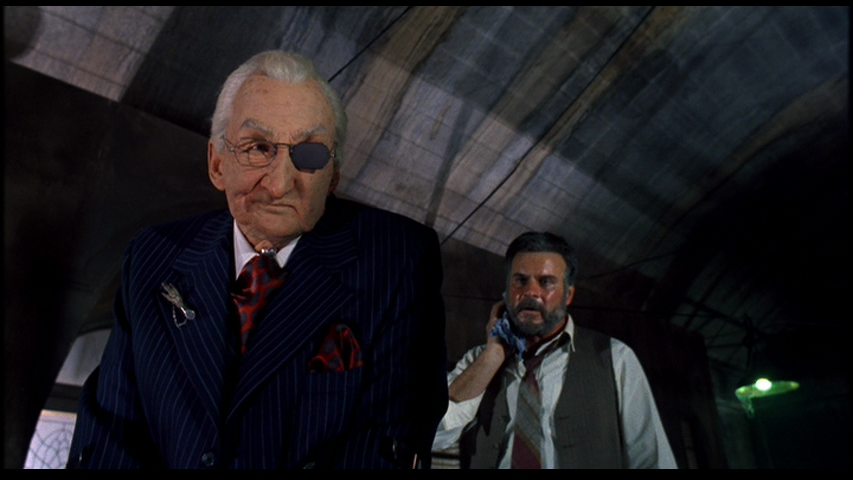
William Gartley and George Stanner in The Mangler.
- The System
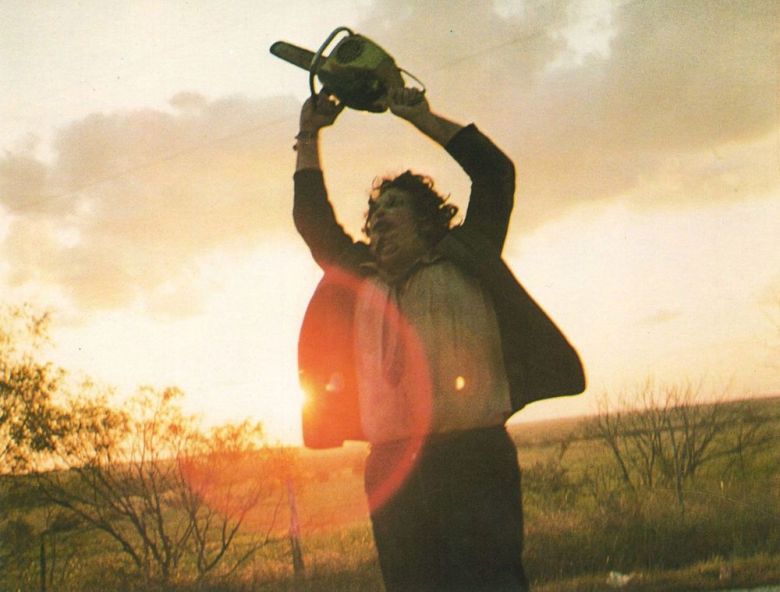
In Tobe Hooper movies, ties are worn by the most dangerous people who either mastermind or are in league with folks who are going to get the good guys killed. In Texas Chain Saw, Leatherface wears a tie to connect him with the old system: the slaughterhouse that closed down. Whether it was losing his job braining cows that sent him into his "casual murder" lifestyle, it seems to at least be responsible for the personality crisis represented by Leatherface's most memorable items of apparel:
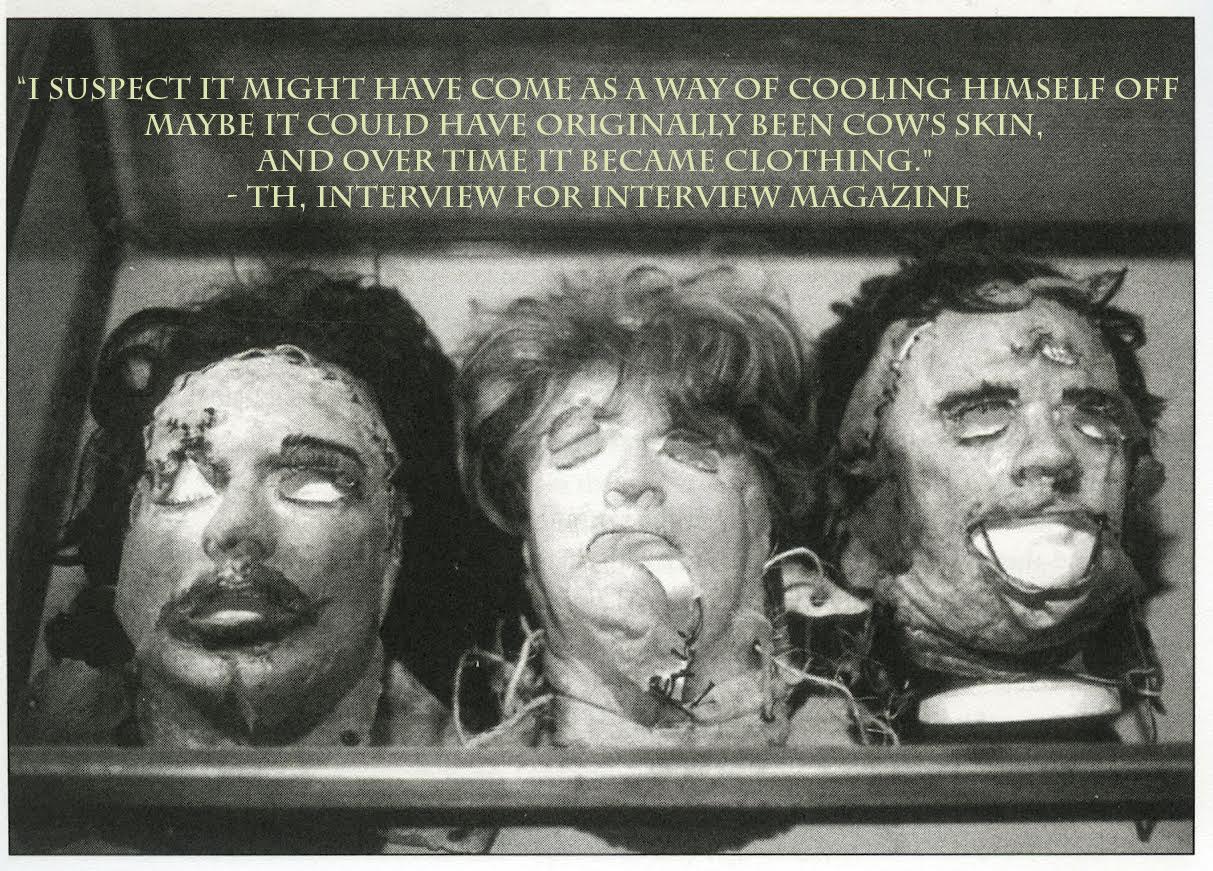
"I suspect it might have come as a way of cooling himself off—maybe it could have originally been cow's skin, and over time it became clothing." - Tobe Hooper, Interview Magazine.
"Leatherface is one of those characters who is what he wears - his character changes according to the face he puts on..." - Kim Henkel, Jaworzyn.
Three masks, three different personalities. This comes up again with the three different barkers in The Funhouse: same actor, three characters in different clothes.
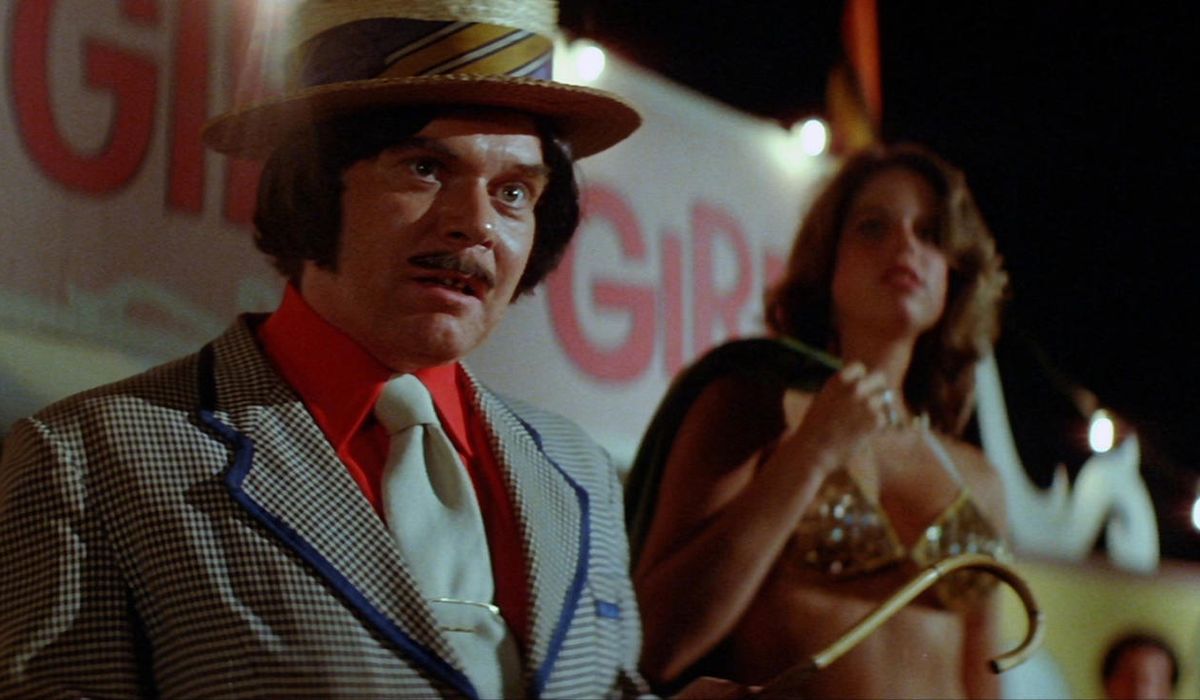
The two most prominently "evil" confederates of the seedy carnival - the flesh-peddling Strip Show barker and funhouse barker/split-headed monster murder spree enabler Conrad Straker*** ** - wear ties.
Judd, the maniac from Eaten Alive, admittedly does not wear a tie. But he wishes he did: among his incoherent rants you hear him say, "Give me the uniform! Even in my uniform. Fine leather hat." Here, for reference, is Judd portrayer Neville Brand in his uniform:
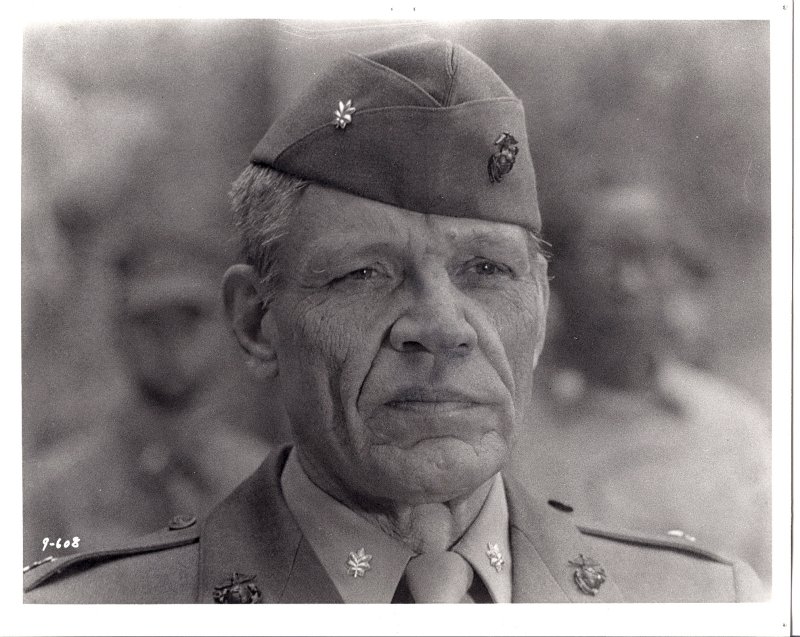
Tobe Hooper associates ties almost solely with sinister agencies, which is why you never see him wearing one - unless Mick Garris makes him.
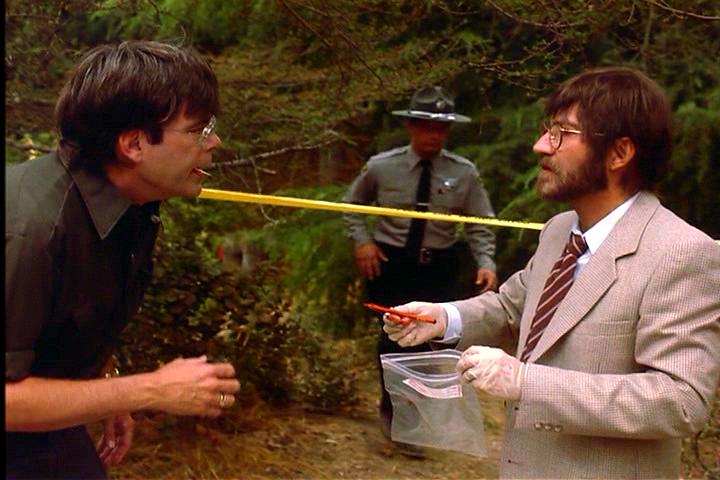
And speaking of Stephen King, let's dive into the all-time greatest Tobe Hooper-Stephen King collaboration...
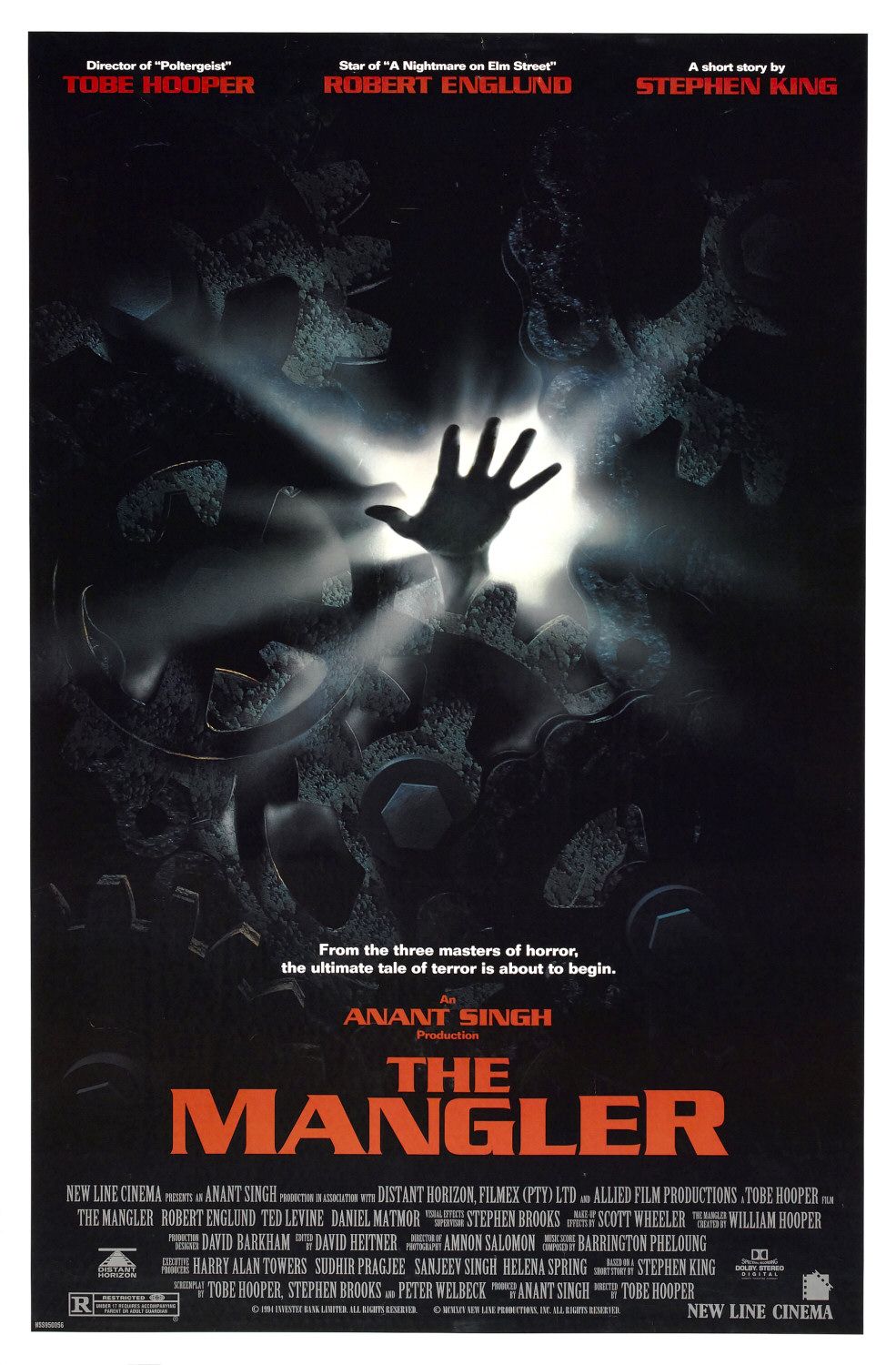
On the surface, The Mangler is the story of a demonic industrial laundry folding machine that eats people. But Hooper took King's original story and turned it into an epic tale of conspiracy and corruption, in which the elite rule over the minority who end up suffering as clothes: they are pressed and ironed. As our hero John Hunton rails following a string of deaths and maimings at the Blue Ribbon Laundry: "Nobody's ass is on the line! Gartley owns Judge Bishop, Judge Bishop owns the sheriff. It's all dirty, it's all dirty! A woman's dead and that machine is running right now, as if nothing happened - business as usual!"
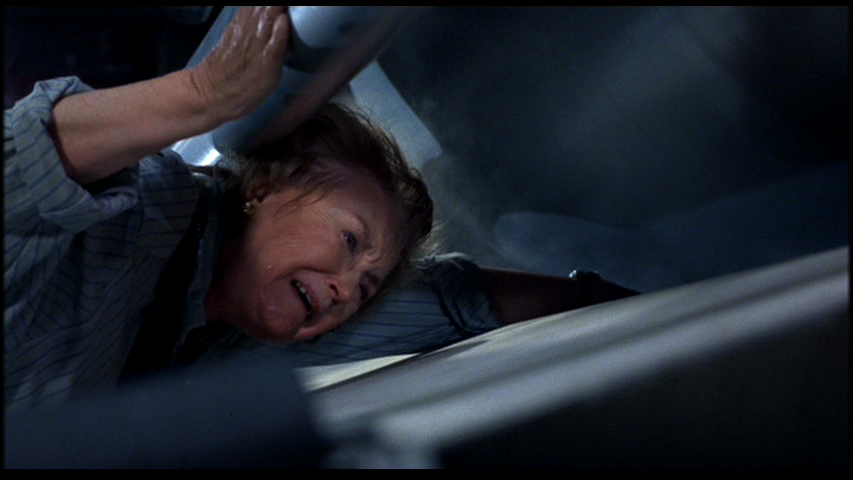
Hunton wears a tie, but it's a dark tie against a dark shirt and therefore very hard to see. This shows that while he's part of the system (a member of the Riker's Valley law enforcement), he's uncomfortable with the fact. Everyone in town connected to the conspiracy at the laundry wears a tie: evil owner William Gartley, his foreman George Stanner, the doctor, the mortician, even the mailman. As the story progresses and Hunton loses his job trying to uncover the all-encompassing conspiracy at the factory, he'll ditch the tie completely and wear a totally different outfit by the film's last scene.*** ***
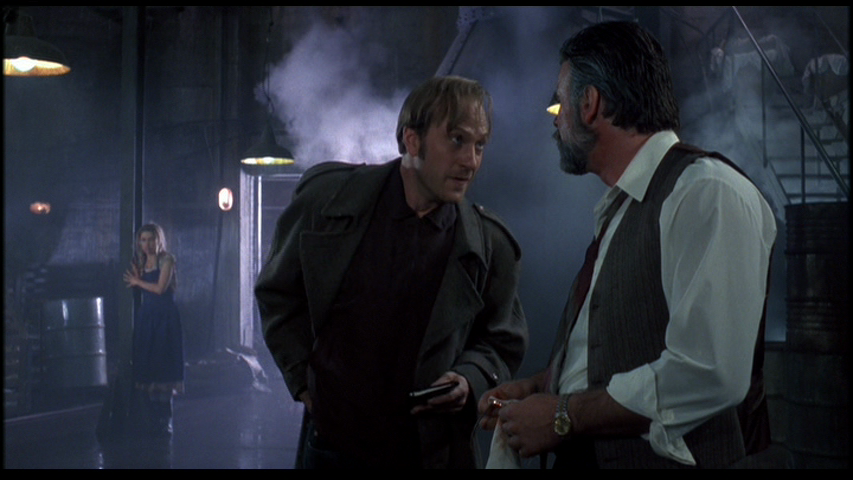
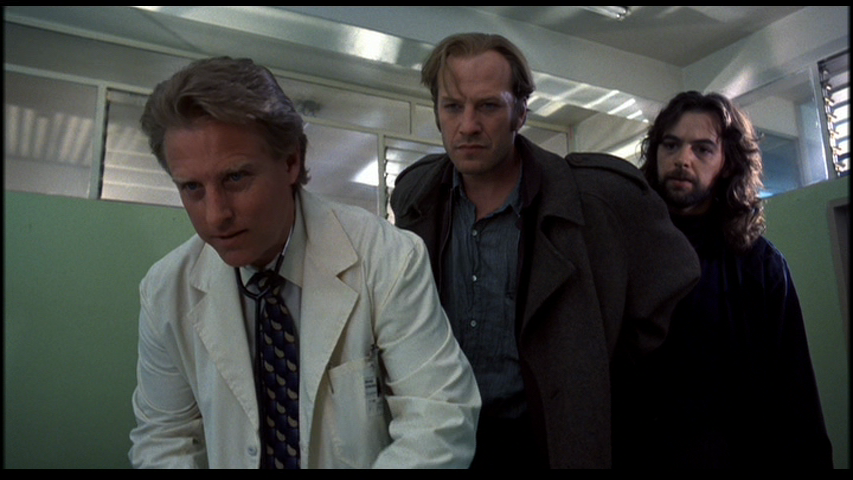
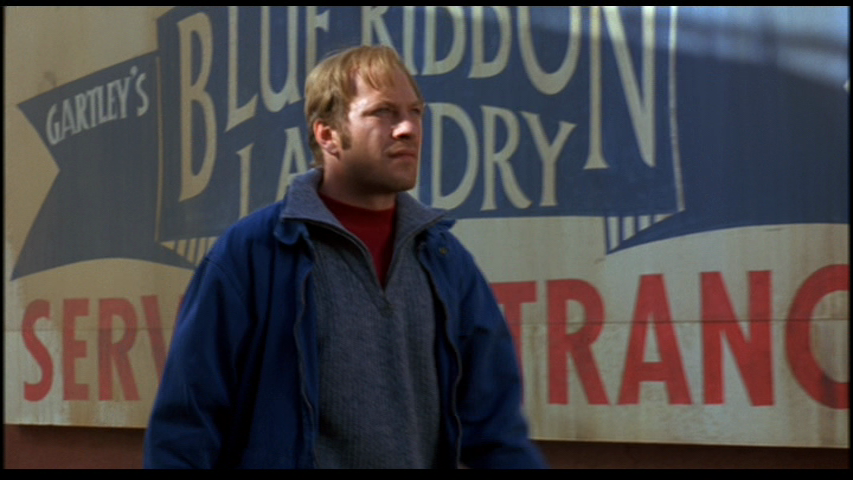
He's not the only character whose relationship to the powers behind the machine is reflected by a wardrobe change. George Stanner, who looks a lot like Leatherface without a mask and reacts to things with the same fretful nervousness, also gets rid of his tie in the very scene he tells Gartley that The Mangler should be shut down. Advancing in the opposite direction, worker Lin Sue goes up to see Gartley dressed in the same blue apron all the factory peons wear. After joining forces with him, she comes back down wearing a whole new outfit, just like Marco the Magnificent's assistant: presto, she's now joined the elite.
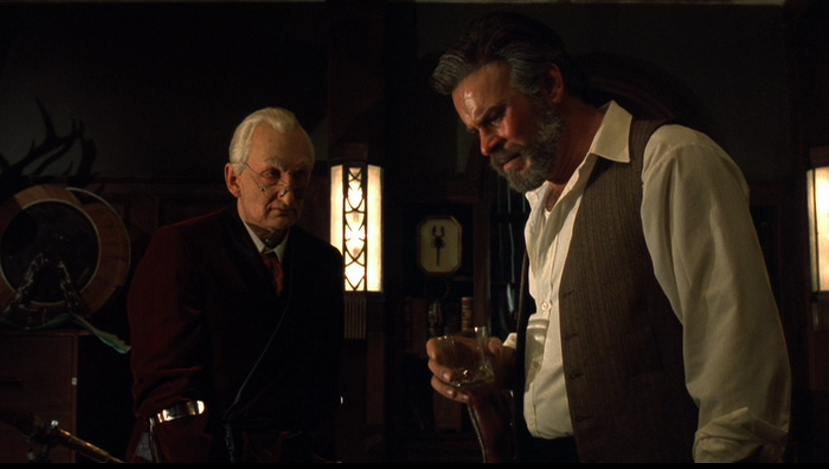
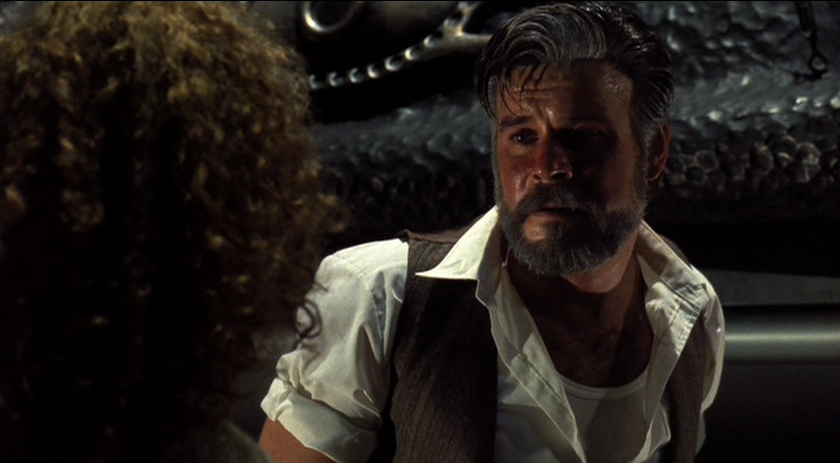
The most telling scene of The Mangler comes in the middle of the movie when the demonic Hadley-Watson Model 6 grabs Hunton by the coat and tries to pull him into its crushing jaws (like Amy's clothes getting caught in the gears of The Funhouse).**** *** Hunton struggles to get loose but finds himself being drawn closer to death. He's forced to pull his gun from his holster and shoot his own coat to free himself. His only choice is to shoot the clothes, because his bullets can't harm the machine.
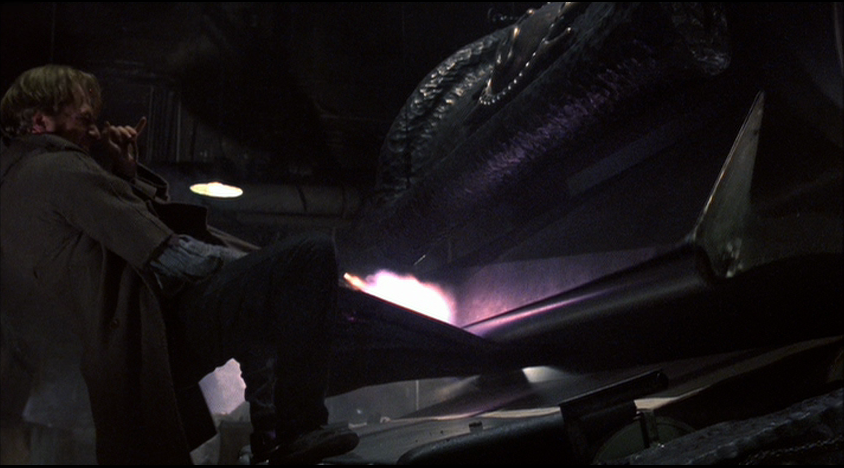
There's a message here: while you may find yourself tethered to the machine, you can always free yourself from the clothes that bind you to it.
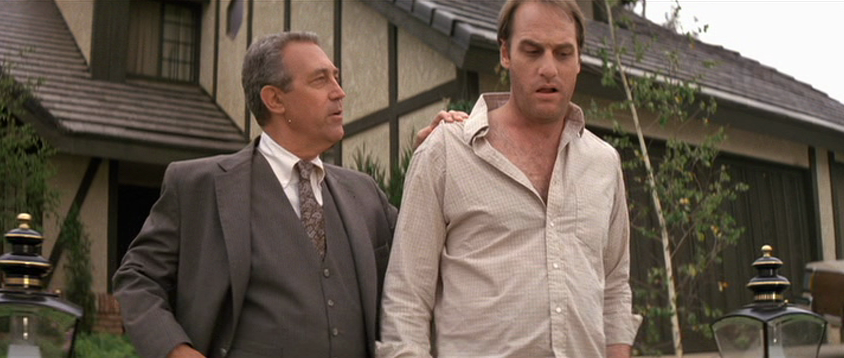
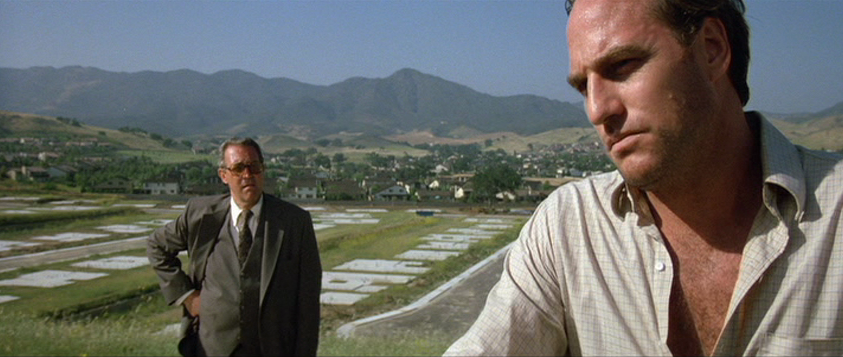
Ultimately this is a major theme for Hooper, the desire to detach his characters from their reliance on the surface facades they share with evil conspiring forces. Several Hooper character arcs involve liberating the good guys from the ties around their necks, literally severing ties from the bad people. Like John Hunton, Steven Freeling stops wearing his work tie in Poltergeist as he becomes more aware of the shady deal his boss made to build the housing development.
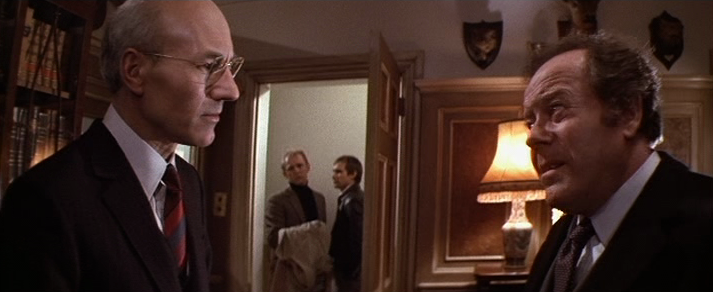
Almost every male character in Lifeforce wears a tie, only to be integrated into the population of mindless drones under the spell of the space vampires. Lead heroes Col. Tom Carlsen and Colin Caine go tie-less and are immediately suspicious of tie-wearing Dr. Armstrong, head of the sanitarium where they've tracked down the Space Girl. Sure enough, Armstrong is really the monster in disguise. Carlsen liberates the Space Girl from her Armstrong "suit" just as she later liberates him from his own clothes.
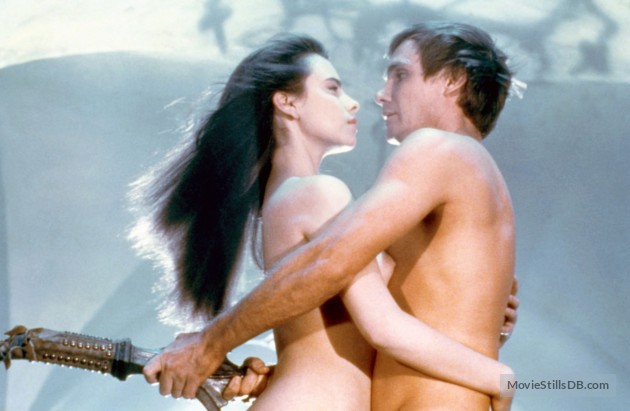
This is something that goes all the way back to the beginning with Hooper's first feature, Eggshells. One of the main characters, Amy, is getting married and in a scene late in the movie she tries on her wedding dress. Standing atop a stool, she's elevated above the other occupants of their communal home not unlike Space Girl at St. Paul's.
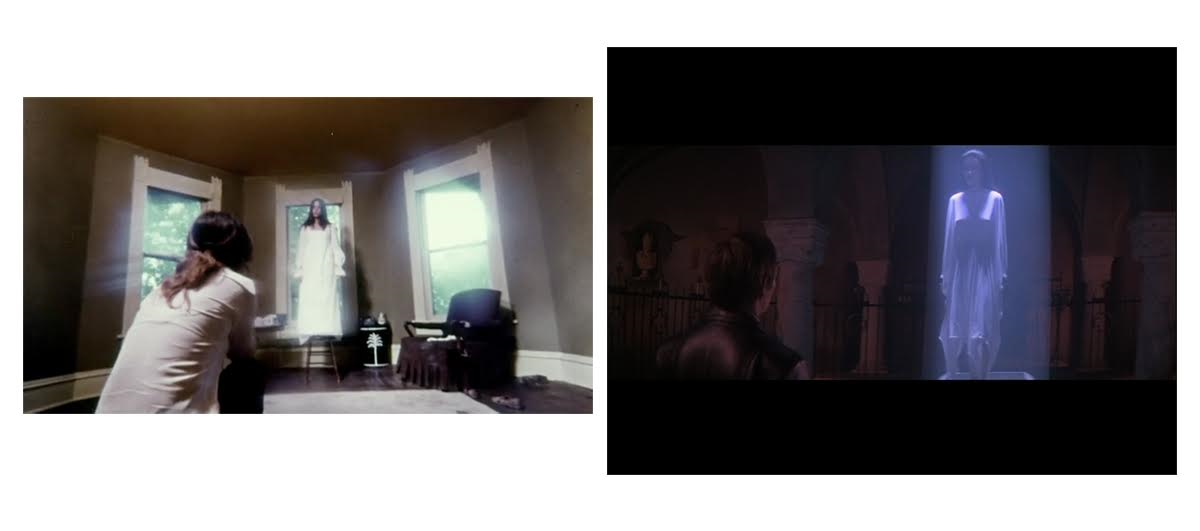
This is the first apperance of the Tobe Hooper white dress that stands for conformity. Toes, a proud hippie living in the house, isn't happy with Amy's little display.
Housemate #1: Because it's a wedding dress you hate it or because of what it looks like you hate it?
Toes: 'Cause it's a wedding dress and actually standing up on that stool, doing that stuff.
Housemate #2: So you don't really hate the dress, you hate the symbolic.
Toes: Yeah.
Toes doesn't trust the institution of marriage, hates the symbolism of the dress, clearly feels threatened by the fact that Amy's placing herself over the others flaunting it. Quite simply, he thinks Amy has blown it.
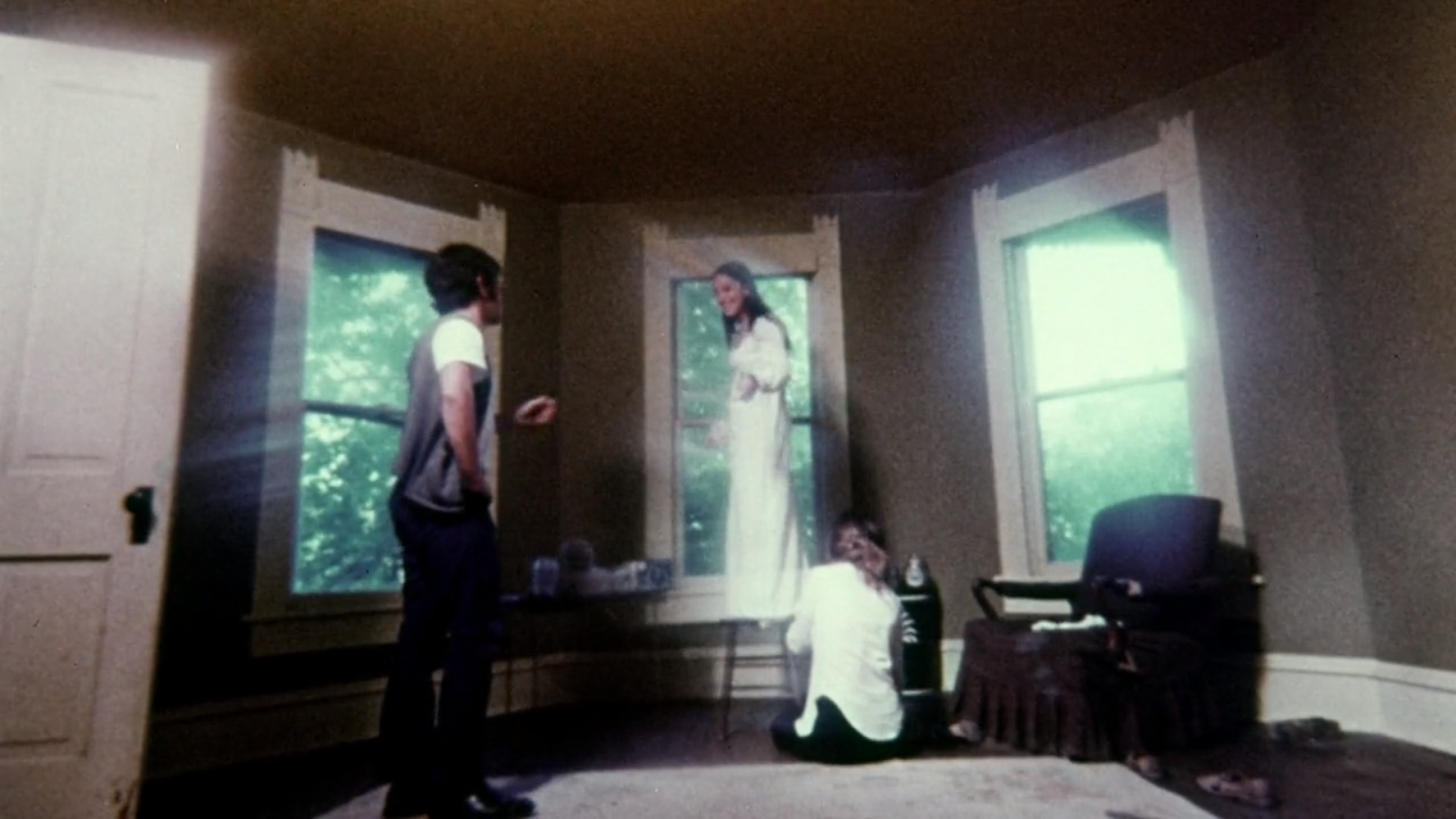
Seemingly in retaliation, in the very next scene Toes drives his weird bubble-domed car out to the country (it may even be Amy's car, the narrative is more than a little oblique). Exiting the car, he breaks the windows, doses the interior with gasoline and lights it on fire. Then he strips off his clothes, tosses them into the car**** **** and runs naked from the vehicle as it explodes behind him in slow motion.
Is Toes speaking on behalf of the director? Could be: the name "Toes" is similar enough to "Tobe" and he's played by Hooper's Texas Chain Saw/Eaten Alive co-writer Kim Henkel. At the very least, Hooper has always been interested in situations that devolve from order to destruction and the exploding car from Eggshells is no exception. The reaction may be extreme, but Toes/Tobe seems to realize, just as John Hunton when he shot his coat to disconnect himself from the machine: Sometimes you have to murder your outfit.
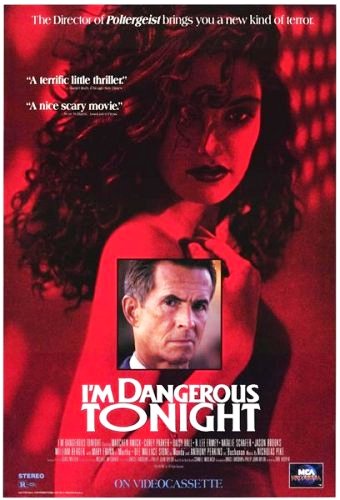
All this makes Tobe Hooper's 1990 TV movie I'm Dangerous Tonight an important part of the Hooper canon rather than a minor late period work. Dangerous is the story of a haunted cocktail dress that possesses the mind of the wearer and compels them to do bad things. It's Hooper's version of the Cinderella story by way of the possession horror movie, with the neglected wallflower's transition to confident butterfly leaving behind a path of chaos and death. (Tim Lucas more astutely compared the movie to Hans Christian Andersen's tale of the Red Shoes.)
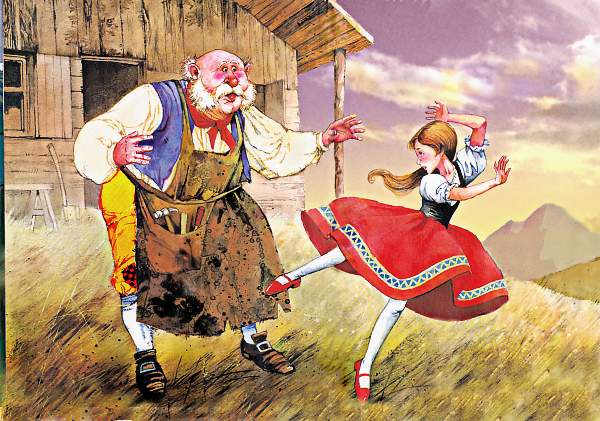
The film is based on a 1937 novella of the same name by crime fiction writer Cornell Woolrich. Woolrich's work was much adapted in the 40's and 50's, notable examples being Val Lewton/Jacques Tourneur's The Leopard Man (a minor masterpiece), Robert Siodmak's Phantom Lady (far and away my all-time favorite noir) and most famously Alfred Hitchcock's Rear Window.* Since then, interesting cinematic interpretations of his novels and stories have come in the form of Francois Truffaut's Mississippi Mermaid (from the book Waltz Into Darkness), R.W. Fassbinder's Martha (an initially uncredited reworking of the story "For the Rest of Her Life"), Richard Franklin's Cloak & Dagger ("The Boy Who Cried Murder") and the Umberto Lenzi giallo Seven Blood-Stained Orchids (based on Rendezvous in Black). One of the few later adaptations to retain the original Woolrich title is another by Truffaut, The Bride Wore Black, connected to I'm Dangerous Tonight by its suggestion that a female character's homicidal disposition could be determined by what she's wearing.
In Woolrich's story, the devil himself pays a midnight visit to a famous, drug-addicted Parisian clothing designer and leaves her his cloak with the suggestion that she turn it into a dress. She does so, after contact with the garment incites her to kill her cat. The resulting frock, which she labels "I'm Dangerous Tonight," is "black on one side, a bright flame-red on the other," includes a "tiny arrow-headed train... like a devil's tail" and emits "an odor of musk." The first model to fashion it decides to steal the gown and murders a security guard with a pair of shears when he tries to stop her. Woolrich provides a nice description to specify the total baseness of the costume wearer: "She had jumped back - not in remorse, but to keep the bottom of her skirt clear of his blood." (Another nice detail: she takes the dead watchman's keys in anticipation of returning the dress the following morning, as if "borrowing" the gown is the only thing she's done wrong.)
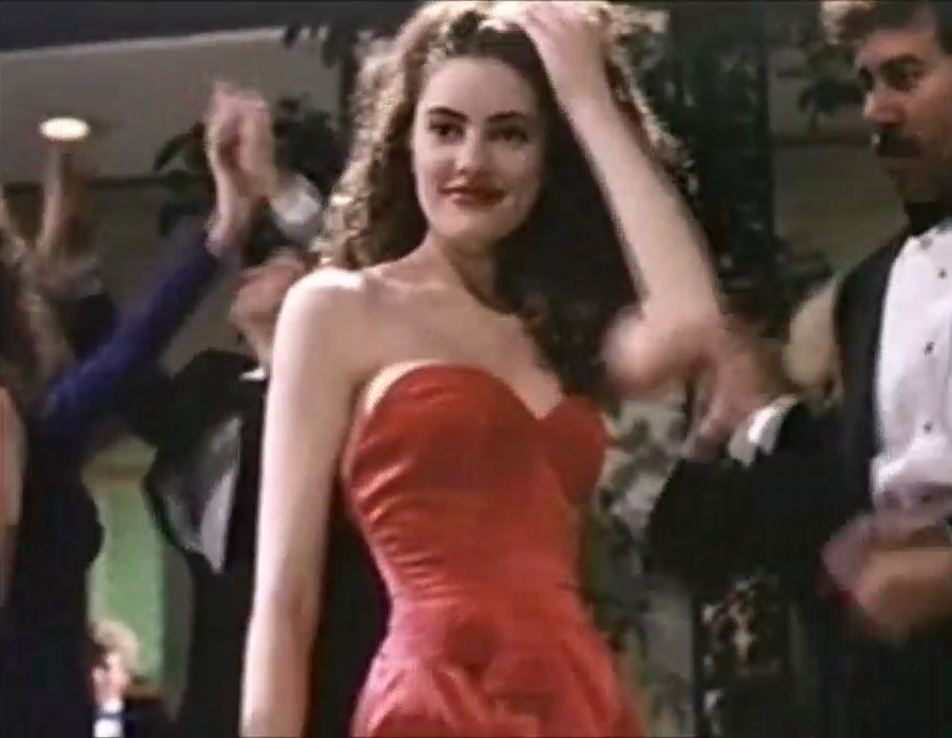
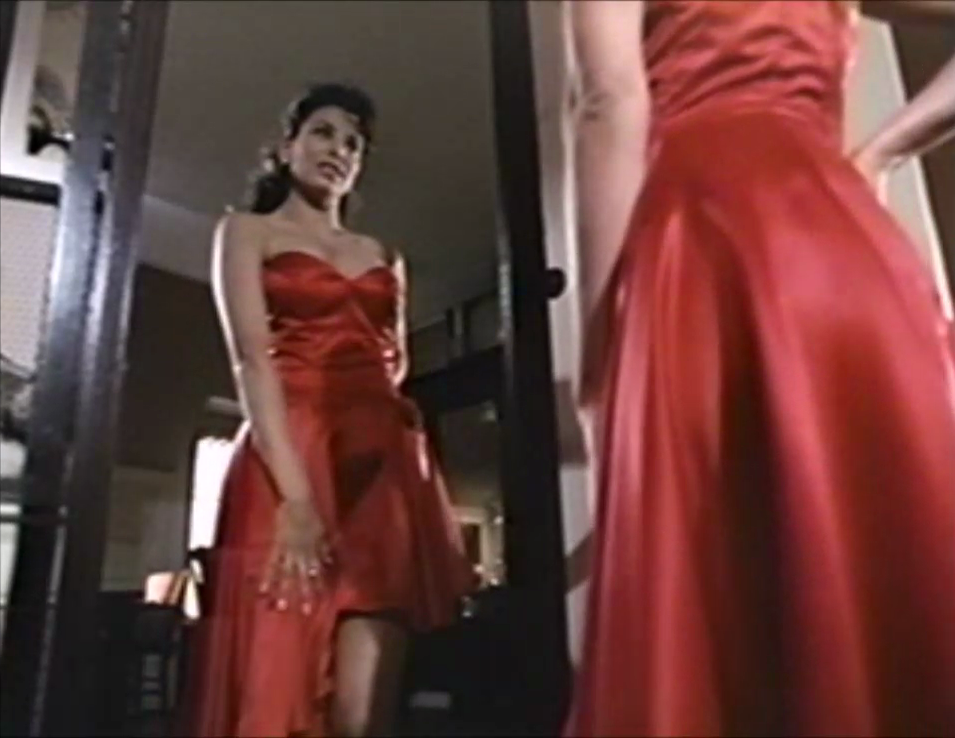
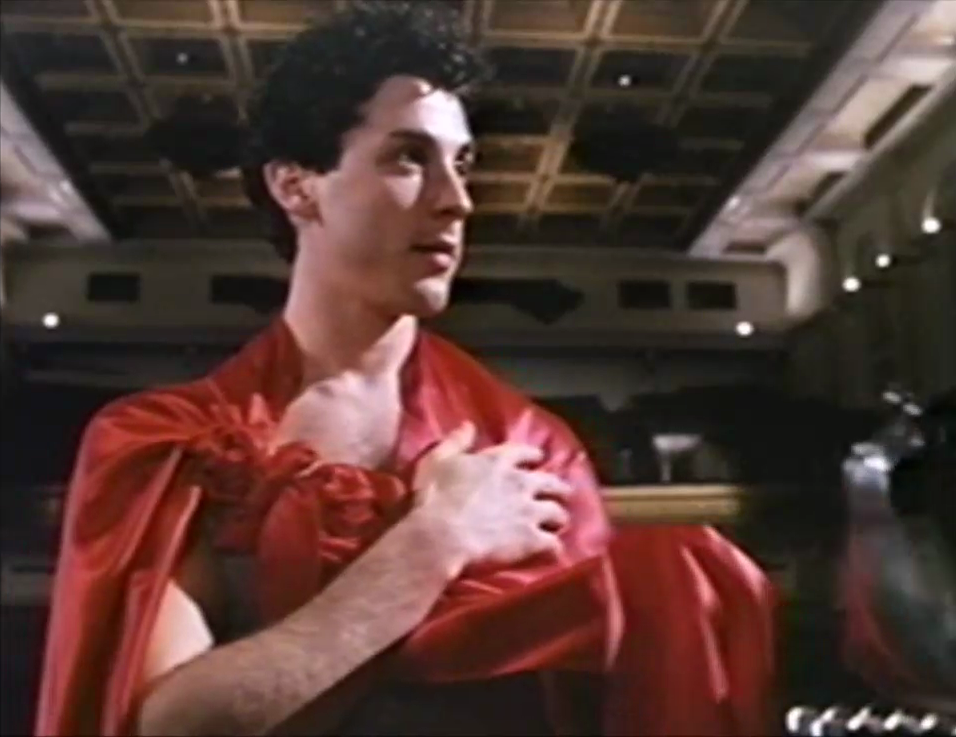
The model is passionately in love with an American drug dealer hiding in France after killing a justice agent. Recalling his fear of being strapped into the electric chair, she's compelled under the influence of the gown to betray him to the cop on his trail (the justice agent killed was his brother!) Giddishly vampish when wearing the dress ("She squirmed eagerly inside the glistening cocoon that sheathed her"), she's immediately appalled by her own act upon removing it and tries to warn her criminal boyfriend, but she's too late and the cop arrests him. She leaps from her apartment window in shame.
In an unbelievable coincidence, the dress is then swiftly sold to a ditsy socialite from Dubuque, who just happens to be traveling back to America on the same ocean liner as the cop and his captured fugitive. The socialite, whose worst offense up to that point in her life involve swiping a hotel salad fork for a souvenir, is overwhelmed with macabre memories like her father wringing a chicken's neck and victims of a car crash she'd once witnessed after trying on the gown: "It was funny...When those things had taken place, she'd felt terrible. Now - remembering them - she found herself going over every detail in her mind almost - lovingly." Fueled by a sensation akin to Salome cradling the head of John the Baptist, she kills a canary, frees the thug, shoves her clueless husband into the dark sea (using the retrieval of her scarf as a ruse) and sets up the cop, who's shot multiple times and left for dead. He had failed to recognize the dress previously worn by his enemy's compulsory snitch, even when presented with the socialite's unsettling smile, "poisonous... the pure distillation of evil... like a gargoyle mask."
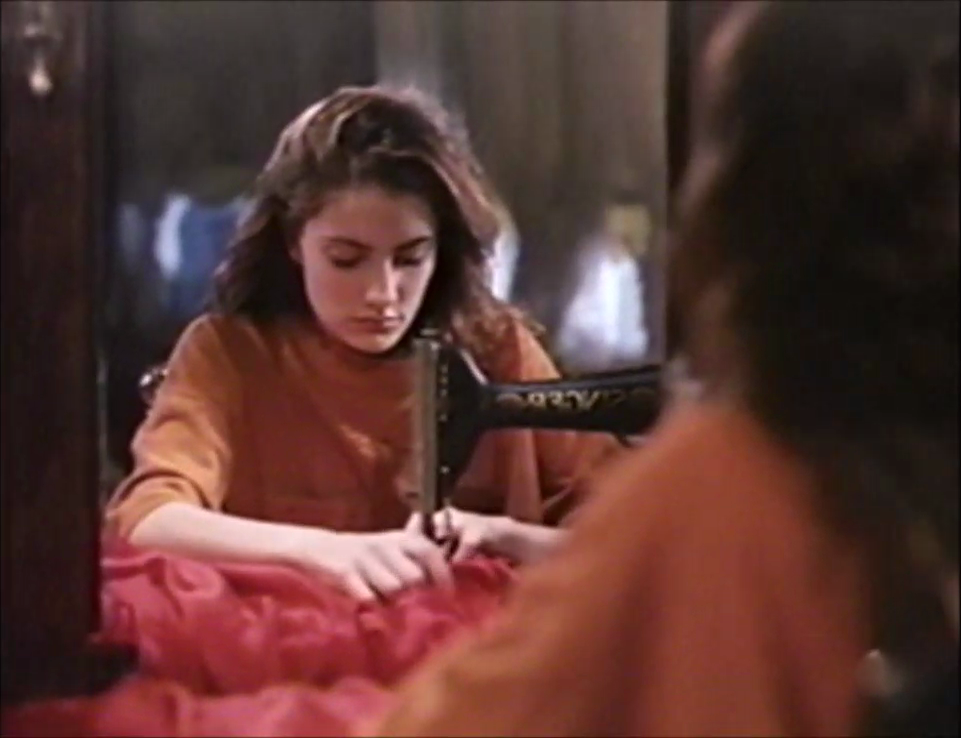
Back in America, the cop has survived but lost his job and climbed into the bottom of a bottle. He's saved by a nightclub singer with a heart o'gold and resumes his pursuit of the escaped drug dealer. In yet another unbelievable coincidence, "I'm Dangerous Tonight" ends up with the singer when her agent purchases it at auction (the socialite went crazy and got committed) and she wears it on the first night of her new job at a sleazy club, which just happens to be run by crooks in league with the drug dealer! Adorned in the insidious drape, she sets the crooks on the undercover cop but luckily he finally realizes it's the dress causing all the trouble. He rips it off the singer and she's instantly rehabilitated, calling for back-up to nail the bad guys just as they're about to ice the cop. Together they burn the remnants where they lay, the charring cloth letting out hisses like "a pit of snakes," a phantom tongue darting from the inferno before fading limply away.
Woolrich was interesting enough to be a Tobe Hooper character. Later in life he became a reclusive alcoholic who ended up losing a leg, like Buck in Eaten Alive. (Only Woolrich's amputation wasn't the result of a war wound or 'gator bite - he got an infection from a shoe that was too tight(!) which he never bothered to seek treatment for, subsequently developing gangrene.) And it's obvious why Hooper, helming his first television movie (he'd previously directed episodes of Amazing Stories, The Equalizer and the pilot of Freddy's Nightmares), would be interested in a story of a piece of clothing that corrupts the individual and ultimately needs to be destroyed.
Satan doesn't appear in Hooper's version; instead, an Aztec ceremonial cloak is removed from a skeleton emtombed in an ancient stone sacrificial altar by Professor Jonas Wilson. Wilson, a believer in animism (the attribution of a soul to inanimate objects) becomes the cloak's first victim. With the cursed garment wrapped around his shoulders, he takes an axe to a hapless security guard (night watchmen just aren't safe in any version of this story) and carves up his wife before committing suicide out of remorse. Wilson is played by William Berger, Austrian-American veteran of over 100 spaghetti westerns, giallos and genre fodder including Today We Kill Tomorrow We Die!, Every Bastard a King, If You Meet Sartana Pray for Your Death, 5 Dolls for an August Moon, A Bullet for a Stranger, The Sinister Eyes of Dr. Orloff, Colt in the Hand of the Devil, The Executioner of God, Superfly T.N.T., Kung Fu Brothers in the Wild West, Love Letters of a Portuguese Nun and the celebrated Jaws-knockoff Devil Fish. He's probably best remembered as musical gunfighter Banjo in the classic Lee Van Cleef western Sabata.
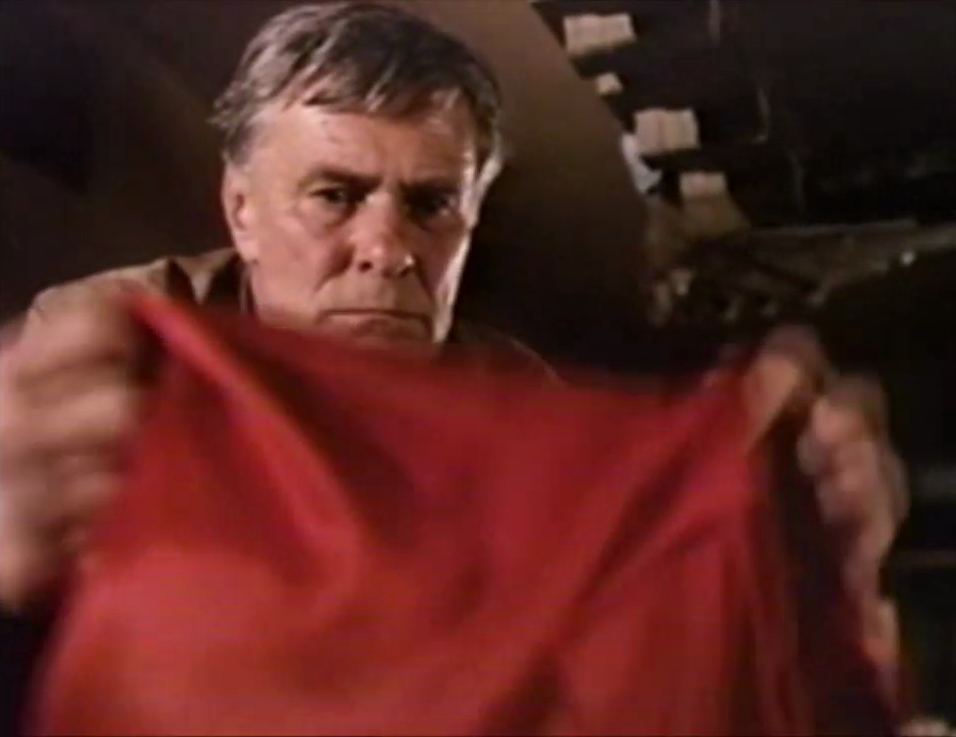
I'm Dangerous Tonight was one of his final roles and the only movie he worked on with his daughter, costume designer Carin Berger. She also happened to be married to Tobe Hooper from 1983 to 1990,* and (billed as "Carin Hooper") designed costumes for every film he directed in that era: Lifeforce, Invaders from Mars, The Texas Chainsaw Massacre 2, Spontaneous Combustion and Dangerous (and later - ugh - Crocodile).** Family is one of Hooper's favorite recurring themes, especially his later films where the idea of heredity becomes important, so it's kind of delightful that his wife designed the evil dress in I'm Dangerous Tonight and his son William designed the evil machine in The Mangler.***
The cloak finds its way to Amy (Mädchen Amick), a college student writing a report on Wilson's textbook on animism for a class headed by his associate Professor Buchanan (Anthony Perkins). As mentioned, Amy is a Cinderella figure, recently orphaned and forced to live with her aunt and cousin Gloria. An amateur seamstress, she thanklessly creates stunning outfits for her demanding aunt and the spoiled Gloria, who for her part does little but flaunt her relationship with a prospect quarterback in Amy's face. This leaves Amy the sole caretaker of their invalid grandmother (Natalie Schafer of Gilligan's Island fame, in her last role, made up to look like a pale corpse only one step away from the mummified granny of the Chain Saw clan). Fed up with being a mousy push-over, Amy stares in the mirror and wanders aloud whether she shouldn't change her appearance to look more like her self-involved cousin, to become more "sophisticated."
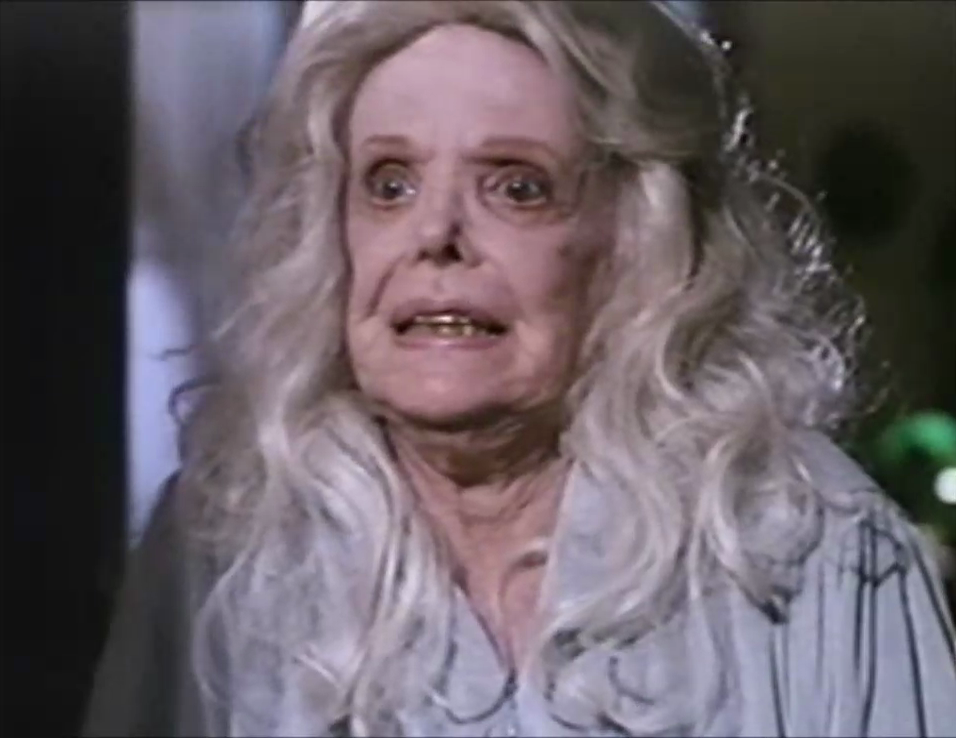
Hooper uses the name Amy for his female lead for the third time, Amick's heroine somewhere between Elizabeth Berridge's virginal victim in The Funhouse and Amy Lester's idealistic independent looking to change her lifestyle in Eggshells. Eggshell-Amy's reliance on a dress to make that change for her is echoed in Dangerous, and the superficial jock who looks to remove it (not for reasons of personal liberation) recalls Buzz's efforts to get Amy out of her clothes in The Funhouse. Funhouse and Dangerous could almost be part of a trilogy of Tobe Hooper movies in which the main character's attempt to detach herself from a dysfunctional family situation only ends up isolating her and leaving her exposed to a series of degradations (Night Terrors being the third example). For Amick's Amy, this starts the night she feels suddenly inspired to fashion the strange red cloak into a cocktail dress.
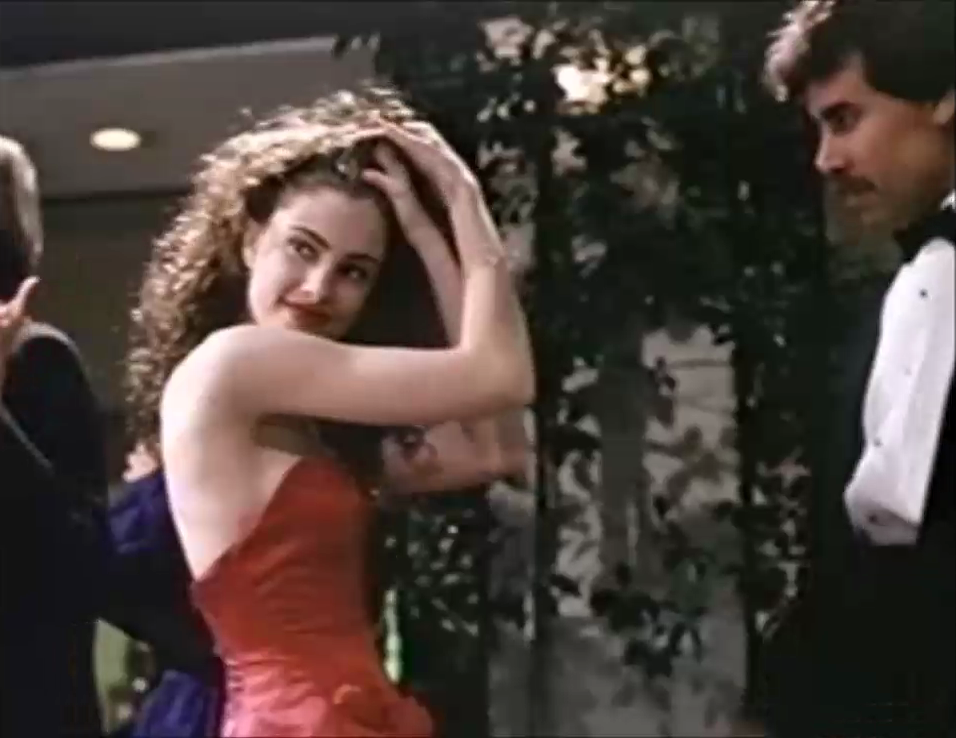
Cinderella appropriately debuts her new look, and new "dangerous" persona, at a dance where she upstages Gloria and seduces the football hero; once he gets her out of the dress she regains her senses and hightails it home. Granny tries to seize the cursed garment from Amy, but crashes through the upstairs bannister and dies, whereupon a repentent Amy ("She was trying to warn me!") discards the dress. Unfortunately Gloria has already gotten a taste of its power and squeezes into the garment to go meet the jock. When it becomes clear he doesn't have long-term plans for their post-coital relationship, she strangles him to death in the shower then castrates him with a razor blade. (Unlike Funhouse's Amy, the football player's Psycho-esque shower demise is not a prank.) Cackling maniacally, Gloria continues to run amok, going after Amy in the jock's massive pick-up truck before crashing and burning in a spectacular sequence that makes me wonder why Hooper never ended up directing a straight-up action movie.
Gloria is swept up in the gleeful abandon granted by the garment like the model in Woolrich's novella, embracing her transition from spoiled brat to serial killer in the spirit of the model's justification for betraying her boyfriend: "I couldn't think of anything I wanted to do more than this. That's why I'm doing it." The dress strips away any inhabitions and allows her to become a force of wanton destruction. She feels invincible wearing the dress, right up to the moment the overturned truck explodes with her inside of it. When faced with being cast off by her short-lived suitor, she detroys his future and Sada Abe's him in a deranged display of female empowerment the repurposed cloak has stirred within her. Her next impulse is to go directly after her romantic rival: Hooper's corrupted females tend to see true threats in members of the same sex, as opposed to the novella where the hostility is always directed at male characters (the boyfriend, the husband, the cop).
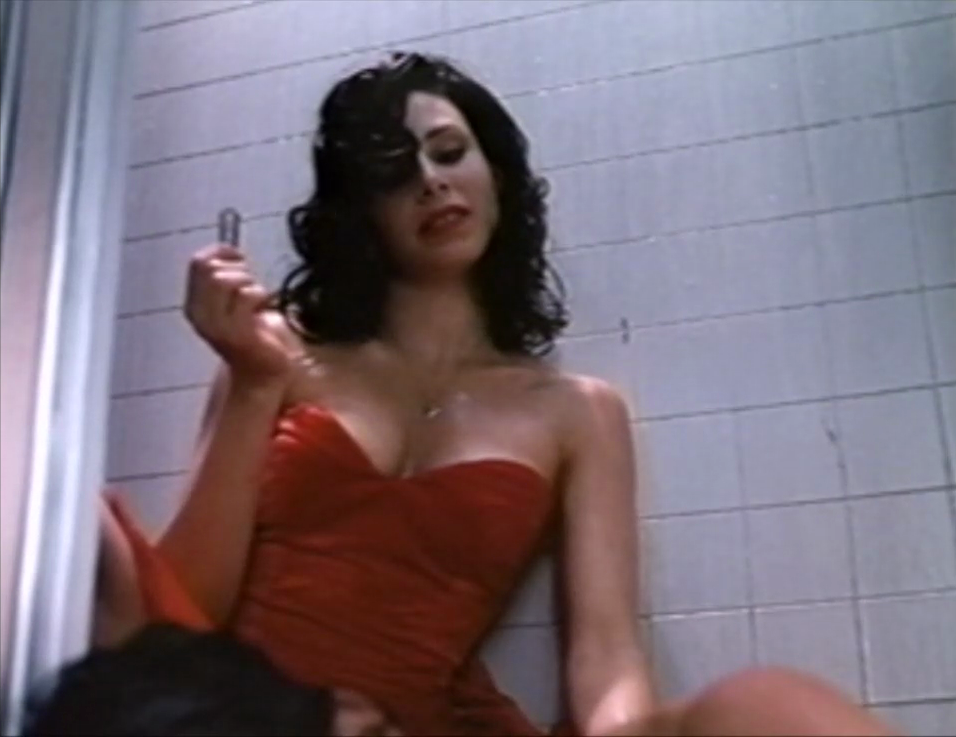
Hooper's film follows Woolrich's basic outline, having the dress corrupt three different women. But whereas Woolrich portrayed his female characters as going from naive, bubbleheaded saints to petty, treacherous femme fatales, Hooper establishes that the effect of the dress is based on the integrity of the person wearing it. If she thinks of herself as a sexy badass, that attitude's going to come out in full under influence of the clothes. Amy's mild disposition prevents her from going full psycho, she can only be turned into, in her words, a "whore," a facade that's achieved by ditching her heavy, dark shirt-and-pants ensemble for the slinky, revealing devil outfit (sans tail-like train). Hooper's always been interested in the sexual personality of female clothes, from Pam's low-cut shorts to this entry by one of the characters from his novel, Midnight Movie:

Hooper acknowledges how dressing sexily jointly affirms confidence as well as insecurity. The fact that the magical material has some positive effects, breaking Amy from her introverted nature and allowing her to stand up to oppressors, is diminished by the superficial advantages granted by any scrap of coveted finery: sanctioned narcissism, social betterment, sexual aggression. Like Cinderella, she's instantly placed above her "wicked" female family members by assimilating their materialistic desires, making a dress for herself.
The script (credited to producers Bruce Lansbury and Philip John Taylor) also has the cloak bewitch three male characters: Wilson, Buchanan and Amy's dorky study buddy Eddie. Strapping it on to rehearse a swordfight for a performance of Romeo & Juliet, he nearly sadistically plucks out his jousting partner's eye before the crimson sash slides off his shoulders. Afterwards he becomes obsessed with the red material that quelled his inhibitions and tries to convince Amy to wear it again (Amick has a nice little thematic line where she asks if Eddie can wait for her to "change" before they go on a walk together). His increasingly insistent request - he eventually puts her in the dress while she's unconscious - characterizes a typical male emphasis on the way a woman should look and act, an attempt on his part to take control of the power of the dress and consequently the freshly dominant Amy. For his part R. Lee Ermey's Lt. Ackman (kind of a stand-in for the cop in Woolrich's story) responds incredulously when Amy tries to explain the influence of the dress to him, holding her under his thumb with baseless accusations and intimidations. Of course, Ackman wears a nice long tie.****
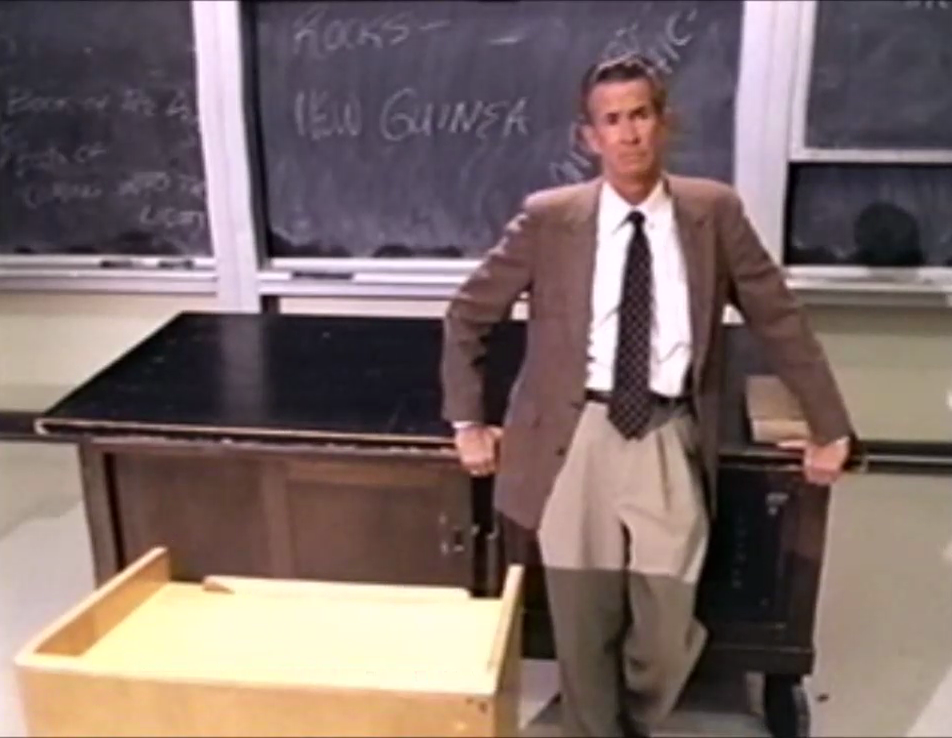
A more subtle attempt to wrest power from Amy is made by Anthony Perkins as Professor Buchanan. First introduced in a tie, he dresses more casually when he first tries to get Amy to tell him where to find the cloak in what I'm guessing is a wool sweater that unsuccessfully attempts to hide the wolf beneath. After getting nowhere with that approach, he becomes more desperate and confronts Amy in a very bold tie to show that he's no longer playing games. (The staging of this scene is, appropriately, Buchanan standing over Amy as she's sitting in her car.) Buchanan's clumsy deception puts me in the mind of Mahmoud from Night Terrors, one of Hooper's best villains. Mahmoud's part in the conspiracy to corrupt Genie is a genuine twist, specifically because Mahmoud seems to have an understanding of what identifies evil people in a Tobe Hooper movie and dresses shrewdly, introducing himself to his mark with the top button open on his dress shirt, clearly not wearing a tie. He's not masked at the costume party. Moreso, we see him riding a horse in the buff (an Arab edition of the Space Girl) and he takes it upon himself to liberate Genie from her own clothes. (Somebody studied the Tobe Hooper playbook!)
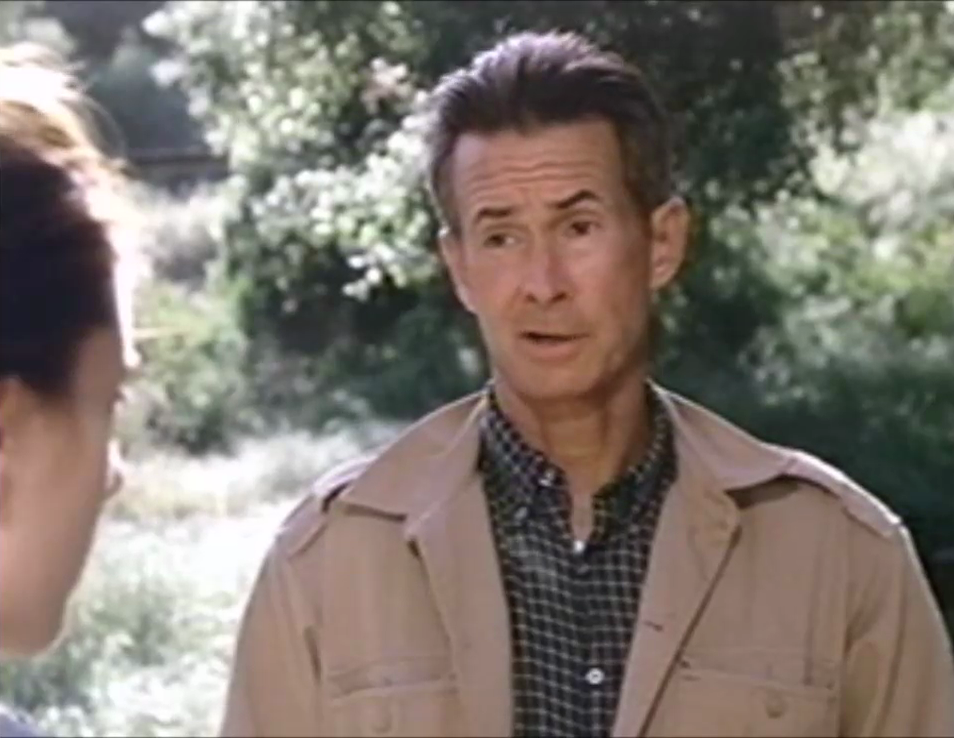
My favorite part of Perkins's performance is his longest scene, in which he makes the most of his clunky expository dialogue with Amy, describing how "certain garments worn in rituals have the power to take control of certain individuals, to possess them as it were" as if he were giving a college lecture. He cites a number of examples: "A cardinal's mitre, an Aztec sacrifical cloak, a Zulu shaman's headdress, that kind of thing." Real subtle, Buchanan! (It's too bad this line didn't set up a trilogy of movies - personally I haven't given up hope on I'm Dangerous Tonight II: Headdressed to Kill.) His likening of the garment to an "amplifier" that "draws out the worst" in its wearers speaks to Tobe Hooper characters who knowingly sacrifice their true selves in favor of clothes that create artificial representations, especially when it's later revealed that despite his warnings Buchanan has designs on the dress.
Perkins of course has an iconic history with a dress "amplifying" identity issues and provoking a murder spree.*** ** After Gloria's been killed and we see the dark silhouette of a female body wrapped in the porloined frock, there's even the suggestion that it could very well be Buchanan in drag. As it turns out the new model is coroner's assistant Wanda Thatcher, who swiped the red dress from the morgue. Remember how I mentioned Hooper appropriating the symbolic red dress from Schindler's List? Well here we've got Dee Wallace, most famous for being in a Spielberg movie, in a red dress! In what's sort of a dress rehearsal (ha) for her stab-happy Caril Ann surro-Fugate in The Frighteners, Wallace plays Wanda as an unstable junkie incited to full-blown self-destruction upon discovering the dress. Amy even spectulates the dress "corrupts like a drug, it corrupts everything it touches!" and that, with Gloria, it has "found a home."
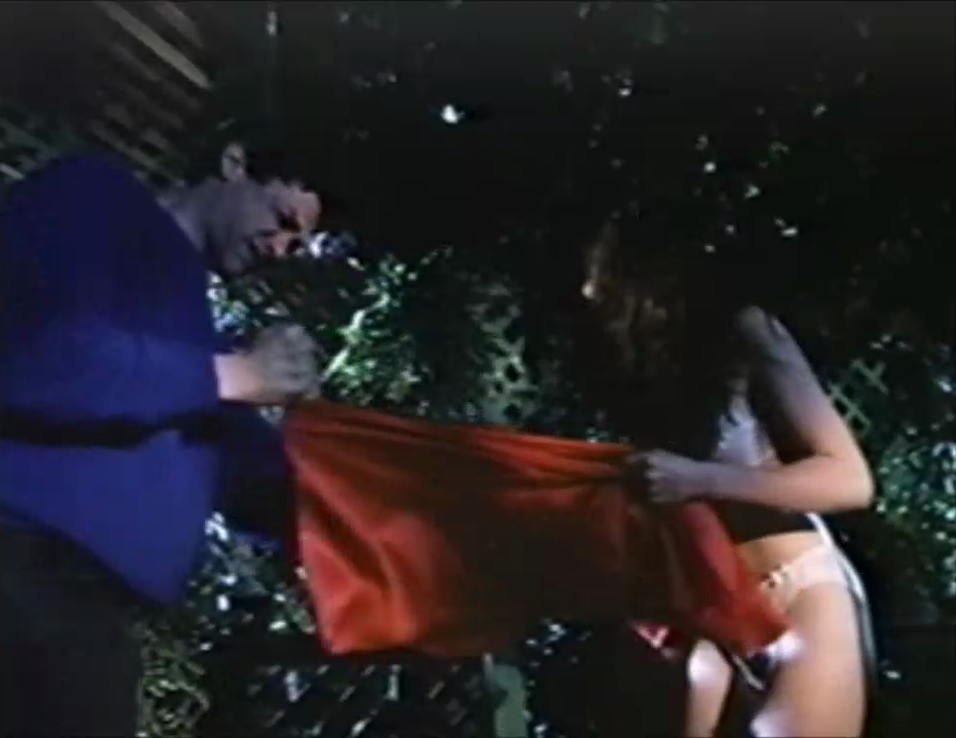
In the film's climax, Eddie overpowers Wanda but falls under the spell of the dress and threatens Amy with a knife. Amy, who has managed to defeat the garment and remove it, gives her big culminating speech in her underwear, imploring Eddie not to let a piece of cloth destroy his pure spirit. Eddie takes the first step against the cloak, stabbing and ripping it repeatedly with the knife he intended to use on Amy as they both hold it. Although she couldn't bring herself to destroy the dress after the death of her grandma, Amy finishes the job by lifting the rags with a pair of gardening shears and dumping them into a wood chipper. (The screams of the cloak's demons as it's torn to ribbons is chillingly effective.) She's quite literally murdered her clothes to announce her independence. She's entered Marco's magic coffin and emerged as the same person who went in.
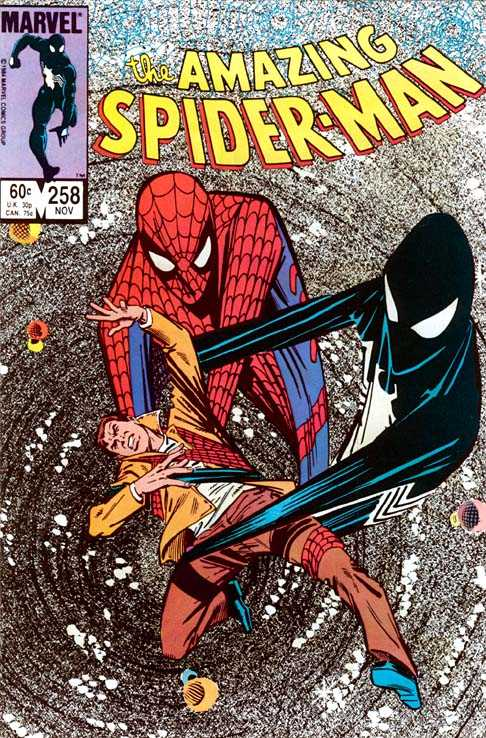
One final interesting connection: Hooper was attached to direct a Spider-Man movie for Cannon in 1985. His involvement with the project was announced just a few weeks after the publication of Amazing Spider-Man #258 (Nov 1984), which wrapped up the "alien costume" saga in which Peter Parker's black Spidey outfit is revealed to be a living amorphous symbiote that takes on the shape of clothing while effectively feeding parasitically off the body and influencing the mind of its host. Peter rejects the symbiote when he learns that it's negatively effecting his behavior and attempting to permanently bond with him - the ultimate evil clothes tale! You figure Hooper, unlike Golan and Globus,*** *** would have been reading the current comic for research at the time and so must have had evil clothes on the brain.**** ***
And I'm Dangerous Tonight closely follows the black spider suit's subsequent story: after being defeated by Spider-Man, the symbiote teams up with Eddie Brock and forms the Spidey-hating villain Venom. So the "good" character rejects the evil duds, and the "bad" character takes the costume and becomes a supervillain. The dress in Dangerous even shares some of the fantastic qualities of the symbiote, its material being impervious to fire and keeping Wanda alive after she sustains fatal injuries from plummeting to what should have been her death. Incidentally, the title of the movie Tobe Hooper was fired from in 1980? Venom!
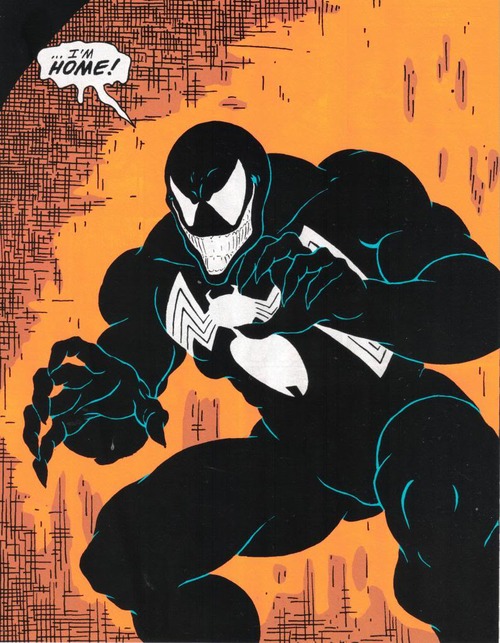
Sam Raimi adapted the symbiote/Venom story in Spider-Man 3, and his version of the story is even more comparable to I'm Dangerous Tonight: nerdy protagonist puts on an evil set of clothes that turns him into a confident asshole. He only manages to hurt those around him, and finally gets rid of the insidious outfit only to have it corrupt someone who tries to kill him. The dance scene of I'm Dangerous Tonight may remind viewers of the infamous one from Raimi's film, when Peter Parker is wearing the symbiote outfit (taking the shape of regular clothes) and manages to musically defeat a romantic rival, isolate someone who cares for him and come off like a general show-offy douchebag. Amick looks dynamite in the red dress, but her cheesy dancing and clumsy plays at seduction show that she's still a shy doofus trying to be sultry. Maguire takes the same approach, translating "cool" through the inexperienced filter of a huge nerd.
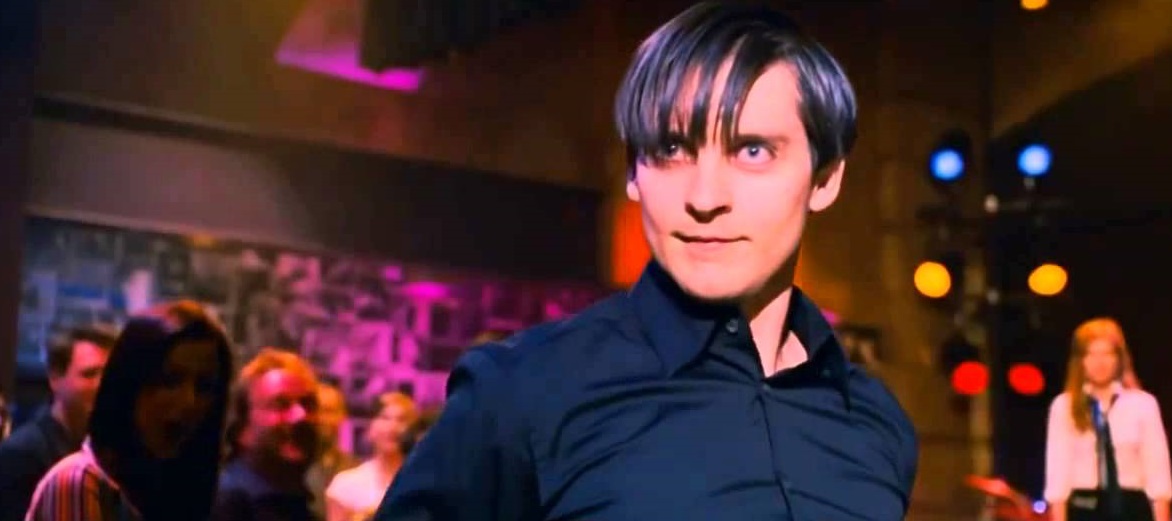
Tobe meets Toby.
~ MAY 30, 2017 ~
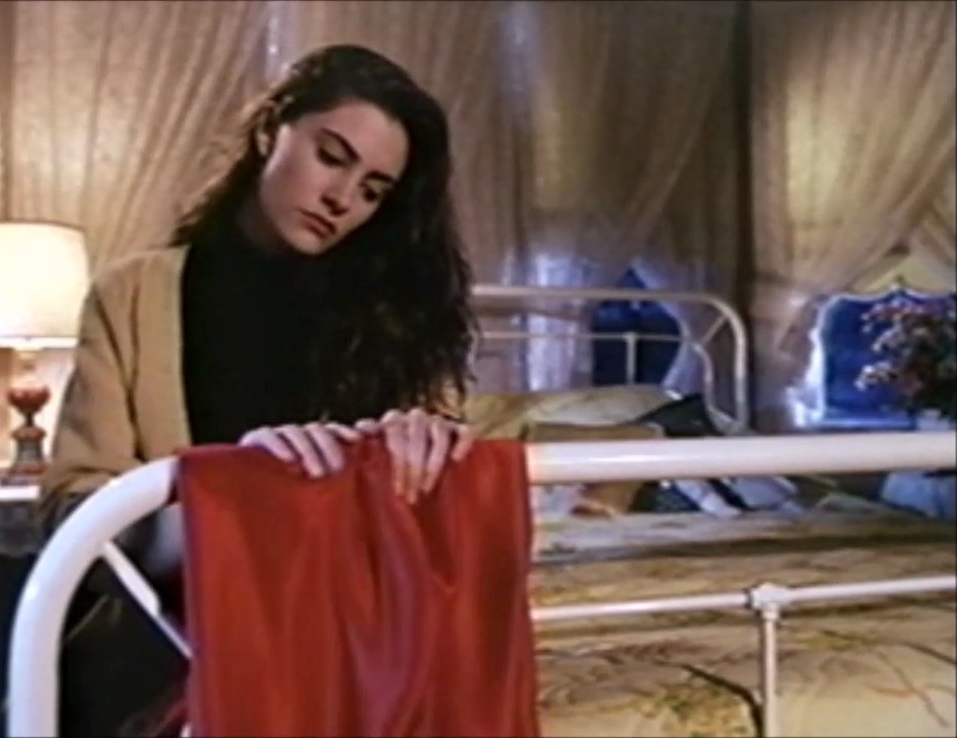
* She wouldn't be the last Hooper character to try and wash off a traumatic experience in the shower (see: The Mangler.)
** In our Wrong Reel podcast on Hooper's work, Kevin brought up that his son singled out this scene as the scariest one in the movie, a really impressive observation given the show-stopping face-ripping and skeleton pools throughout the film. Like father like son!
*** Of course, like these early Tobe Hooper characters, JoBeth Williams was no stranger to having a wardrobe malfunction make her feel vulnerable in front of a male character, from the Oscar-winning Kramer vs. Kramer:
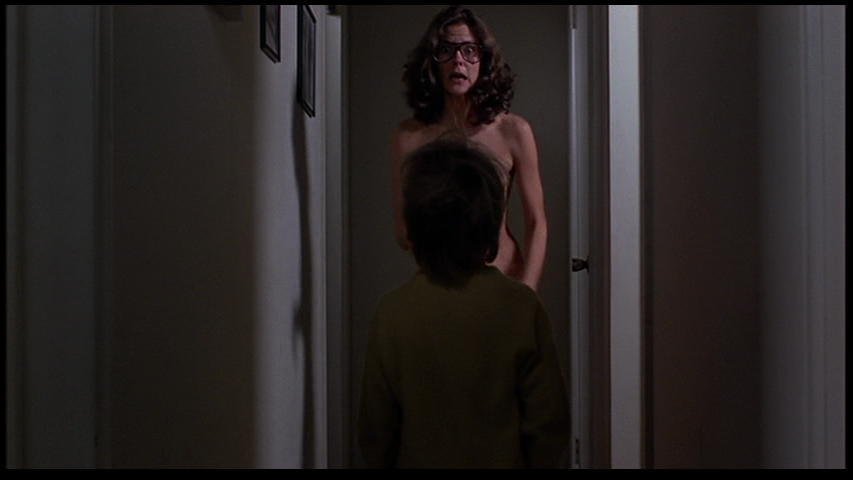
**** According to Hooper, costume designer Barry Kellogg modeled the dress after Jean Harlow's in Dinner at 8.
*** ** Woah, his last name is Straker? Like Richard Straker in Salem's Lot, who also fronts as the human half of a secret monster-based murder duo? I never noticed that!
*** *** Salem's Lot's Larry Crockett also has a blend-in tie, showing that while he's happy to play the game he's not going to be part of the corrupting force that ultimately destroys the town. Same with Conrad Straker, who isn't a kill-happy monster like Gunther Twibunt but has no problem unleashing his monstrosity on the teenagers who endanger their existence.
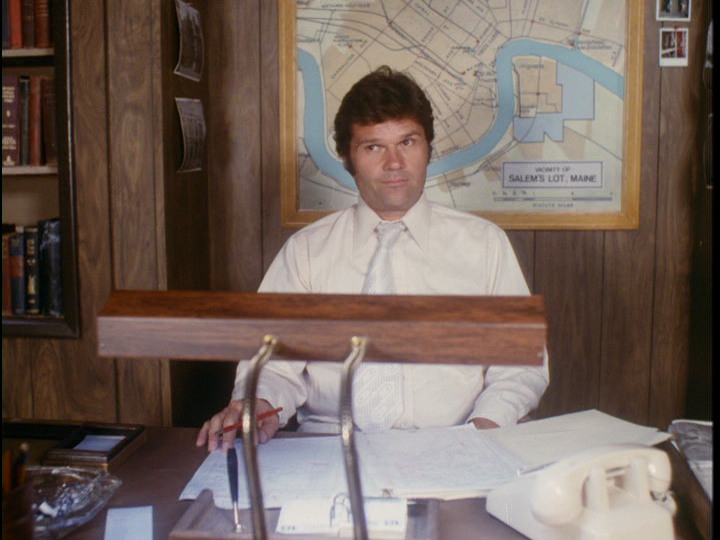
**** *** In a nice little touch, Hunton's coat gets caught in his car door shortly after The Mangler tries to eat him. It reminds him of what's going on around him and further infuriates him.
**** **** Interestingly, the tie-wearing Larry Crockett's clothes are found in his car after he's been bitten in 'Salem's Lot. Also I like to think that the scene in Mortuarywhere Jonathan has to strip off his clothes because they smell of pot is a call-back to Hooper's early trippy experimental film.
* And about a dozen other interesting adaptations including well-regarded noir Deadline at Dawn with a script by Clifford Odets and the Kevin McCarthy-starring classic of paranoia Nightmare.
* Legendary horror movie director Don Coscarelli is also married to a costume designer. David Cronenberg's sister Denise is a costume designer who's worked on every one of her brother's movies since The Fly.
** Berger designed costumes for 1988's Salsa, directed by Boaz Davidson, who was credited with the "story" of fucking Crocodile. (Berger is also credited under "stunts" on Crocodile??)
*** Because her larger filmography is sparse, it's interesting to note that Carin Berger's final costuming credit is the Michelangelo Antonioni segment of Eros, "The Dangerous Thread of Things." This final third of the anthology film ends with two characters meeting clothesless on a beach, which links it with Lifeforce. And Wong Kar-Wai's opening segment, "The Hand", which is about an assistant dressmaker whose client provides him intimate contact as inspiration for the garment he'll be designing for her, is even more thematically tied into clothes, sex and I'm Dangerous Tonight. Berger didn't design the costumes for that one tho - I just wanted to excuse to connect Tobe Hooper with Wong Kar-Wai.
**** I like to think the "tie represents duplicity and betrayal" theme really does connect Hooper's work and career: look no further than the fact that Ermey, after working with him on Dangerous and The Apartment Complex, somewhat betrayed Hooper by accepting the "Cook" role in the terrible Platinum Dune Chainsaw remakes.
*** ** Another notable clothing-based part for Perkins was as a Rome-based photographer in Barry Gordy's Mahogany, in which he reinvents secretary and aspiring fashion designer Diana Ross as an in-demand model, the movie's subtext being that women were meant to wear beautiful clothes, not create them.
*** *** Reportedly, Golan and Globus didn't know shit about Spider-Man and launched their adaptation under the assumption that Peter Parker was a Wolfman-type character who transformed into an eight-legged monster!
**** *** Another Marvel-tastic foonote: in Poltergeist, Robbie is seen reading a copy of Captain America #259, in which Cap fights Doctor Octopus - a Spider-Man villain!



























































































